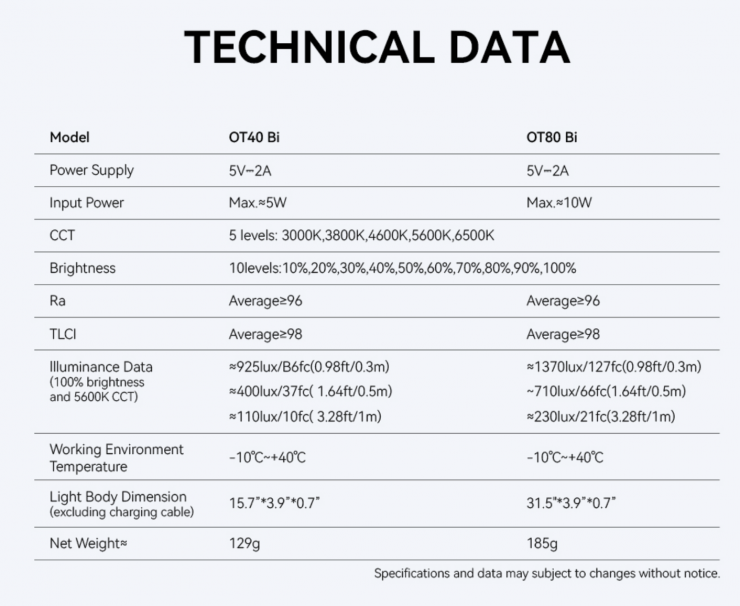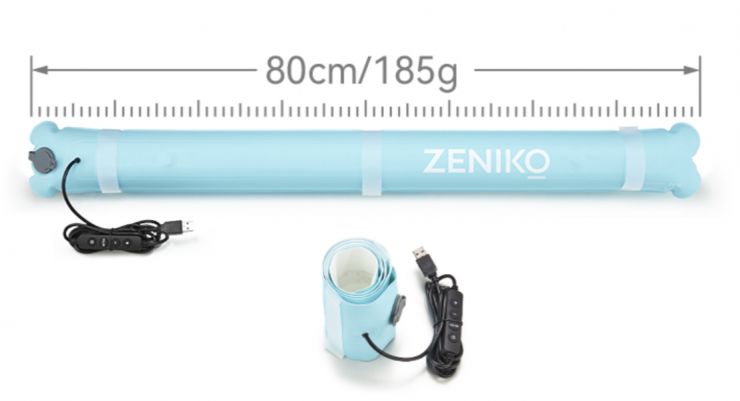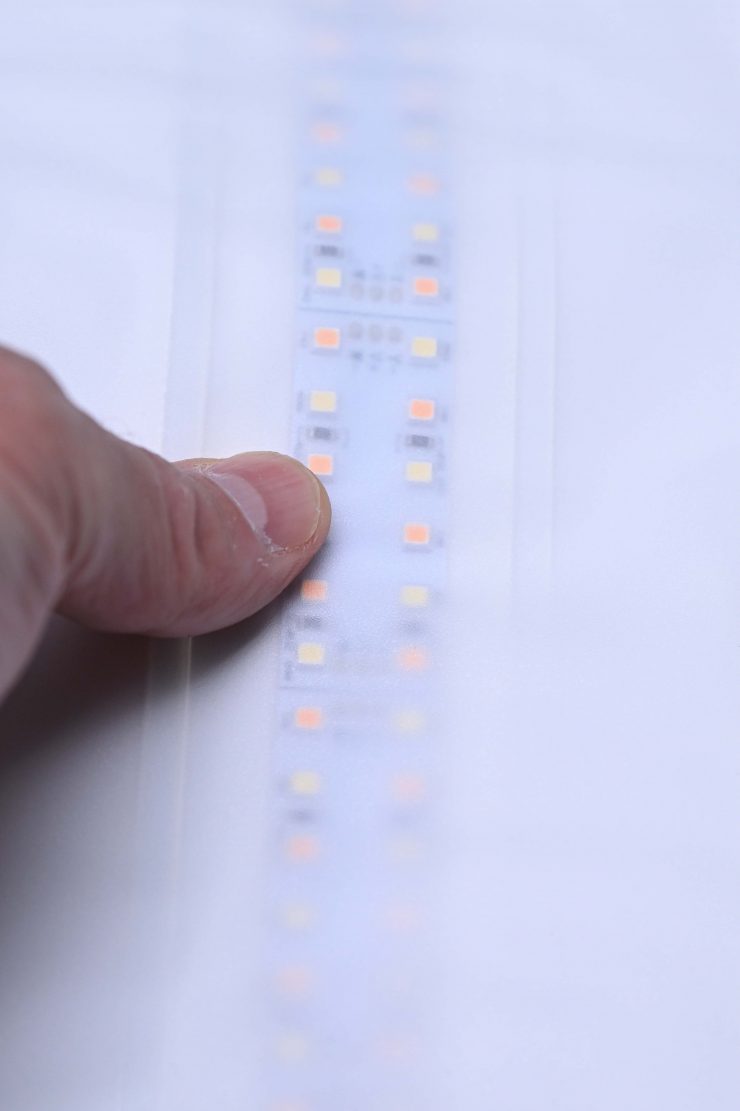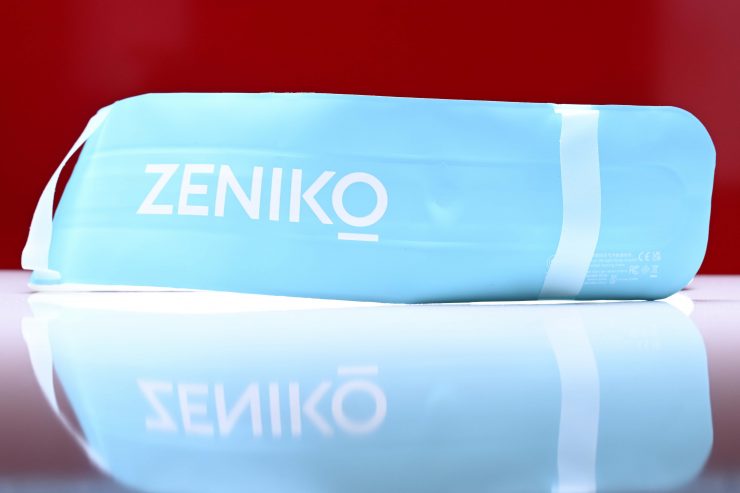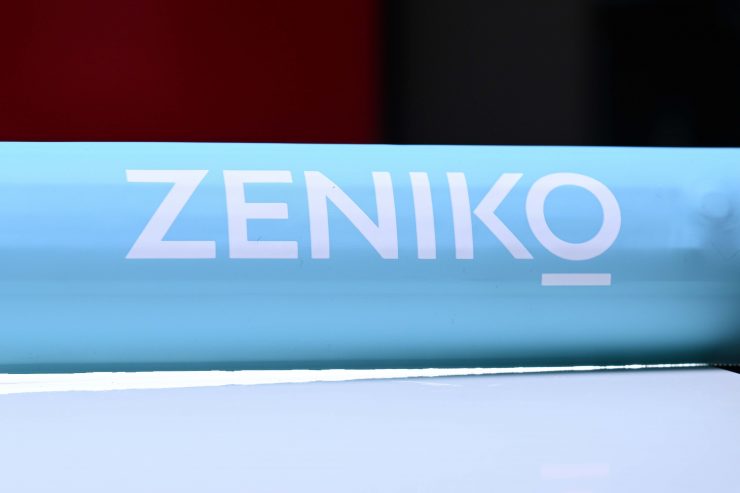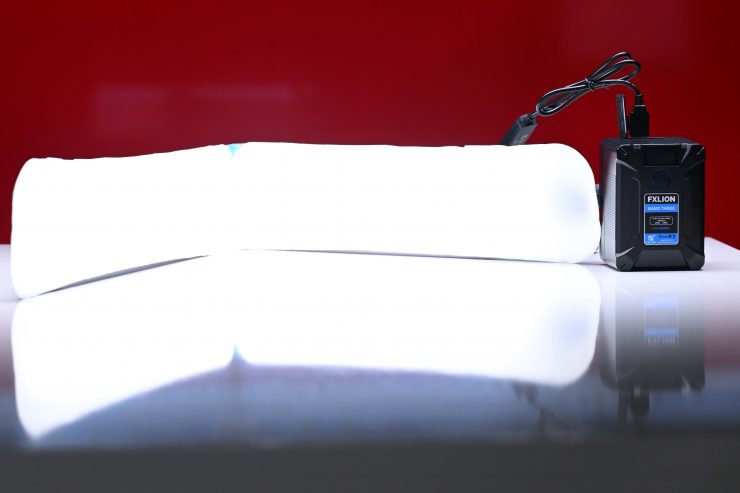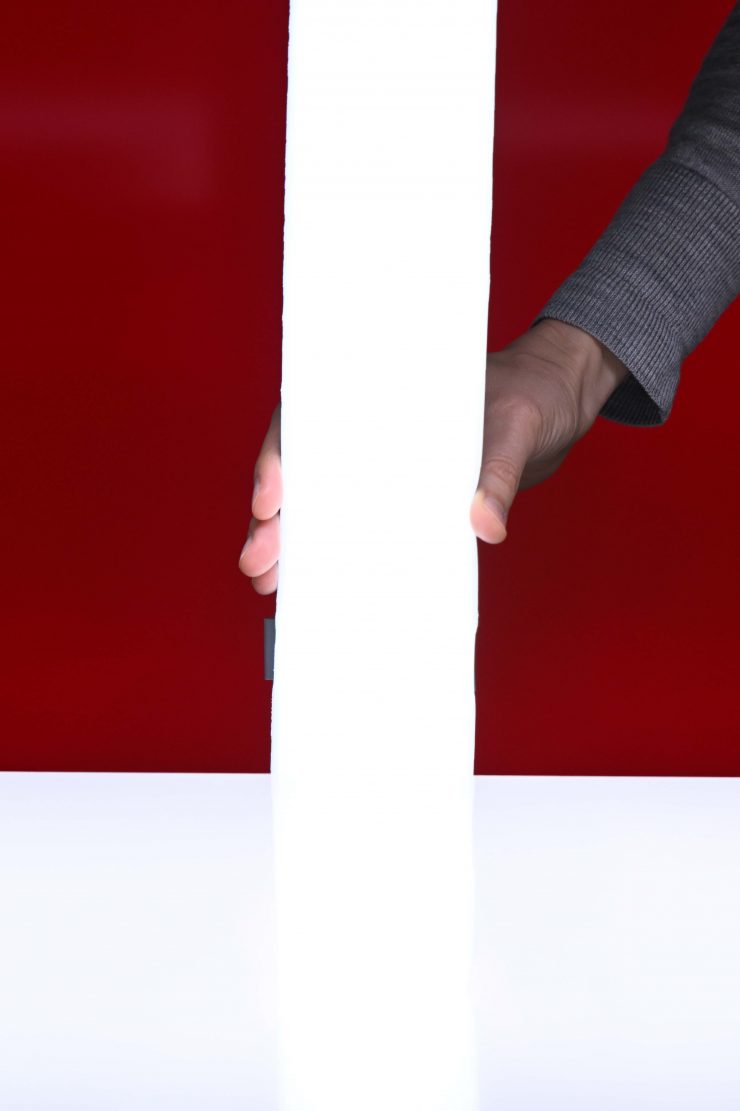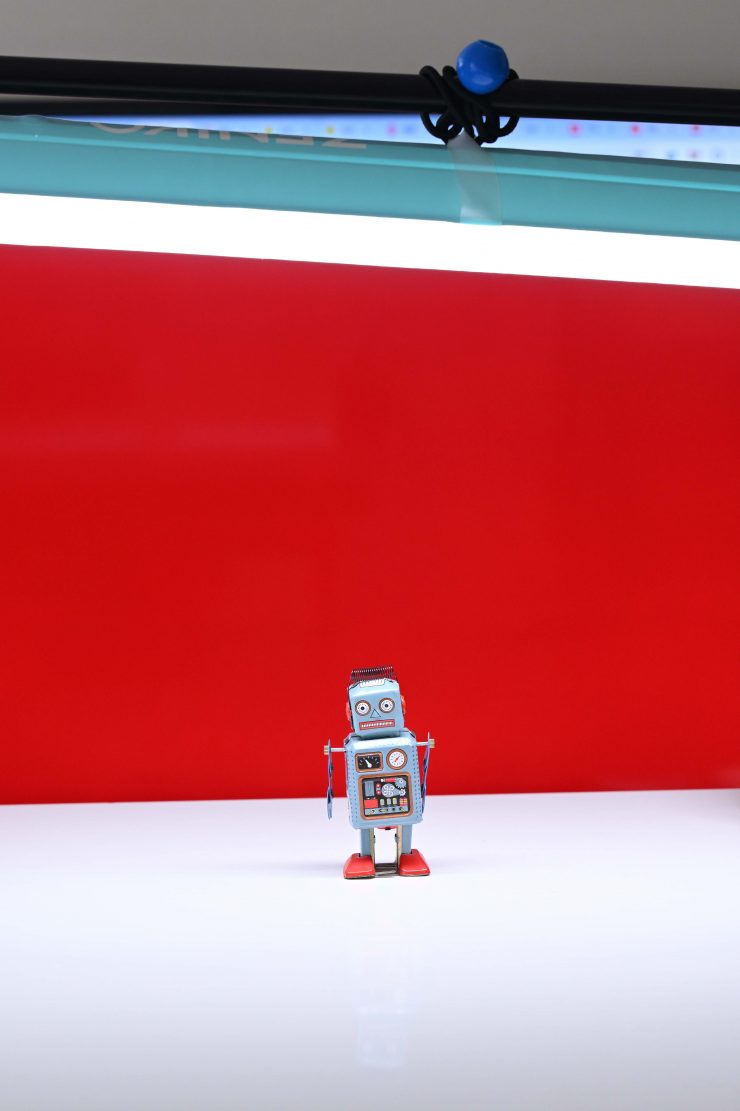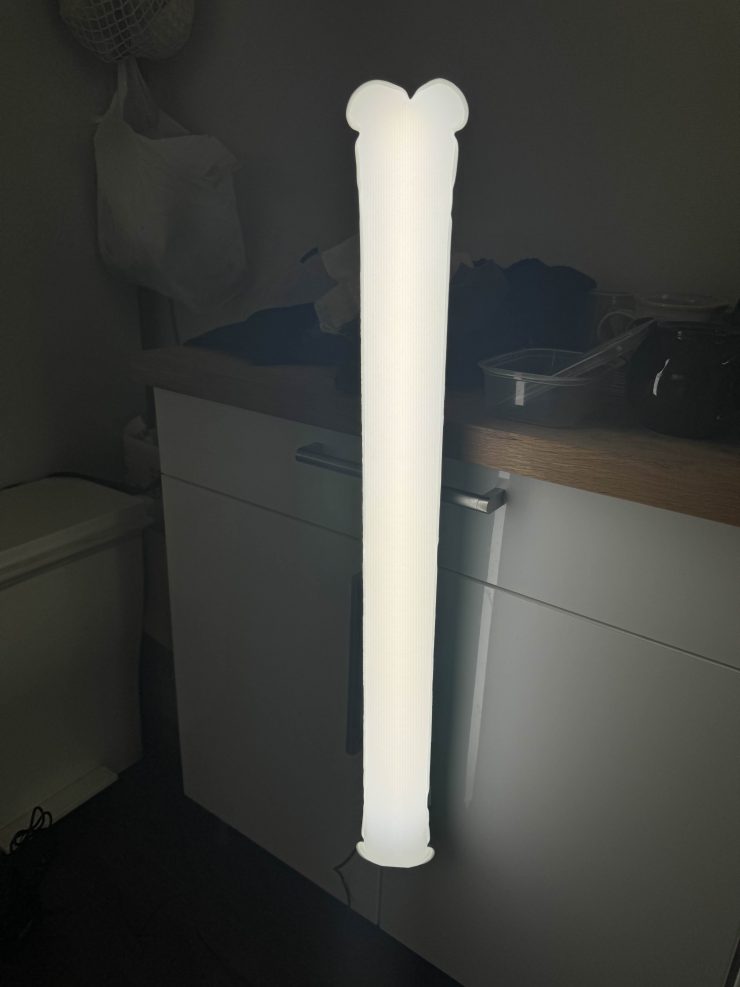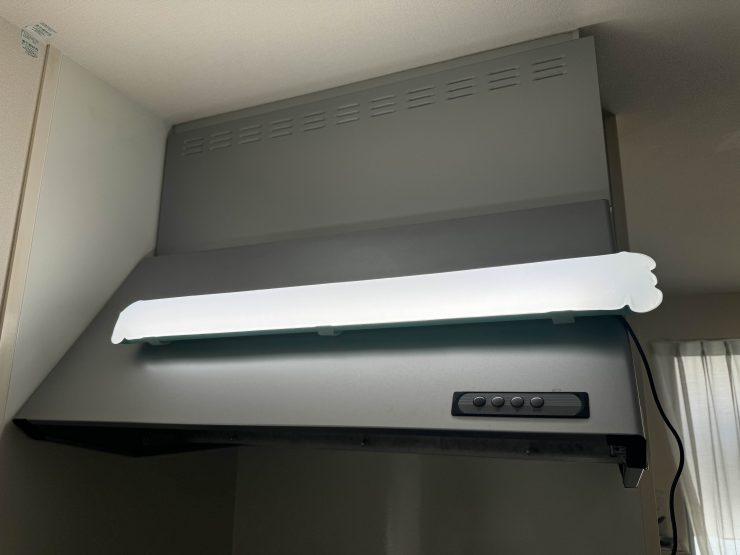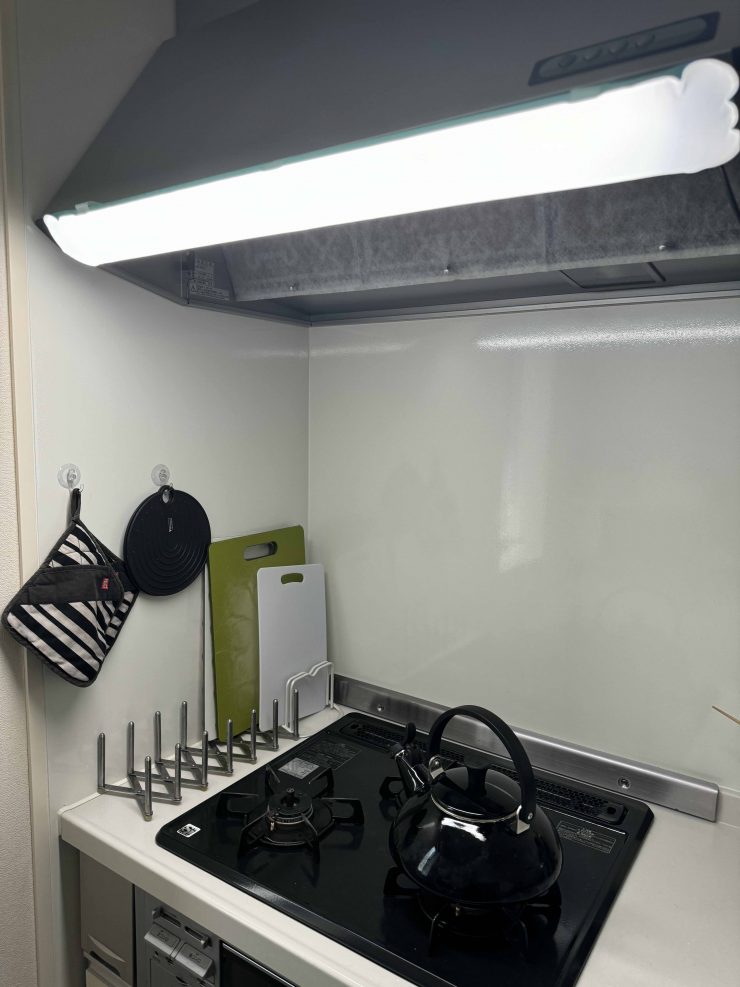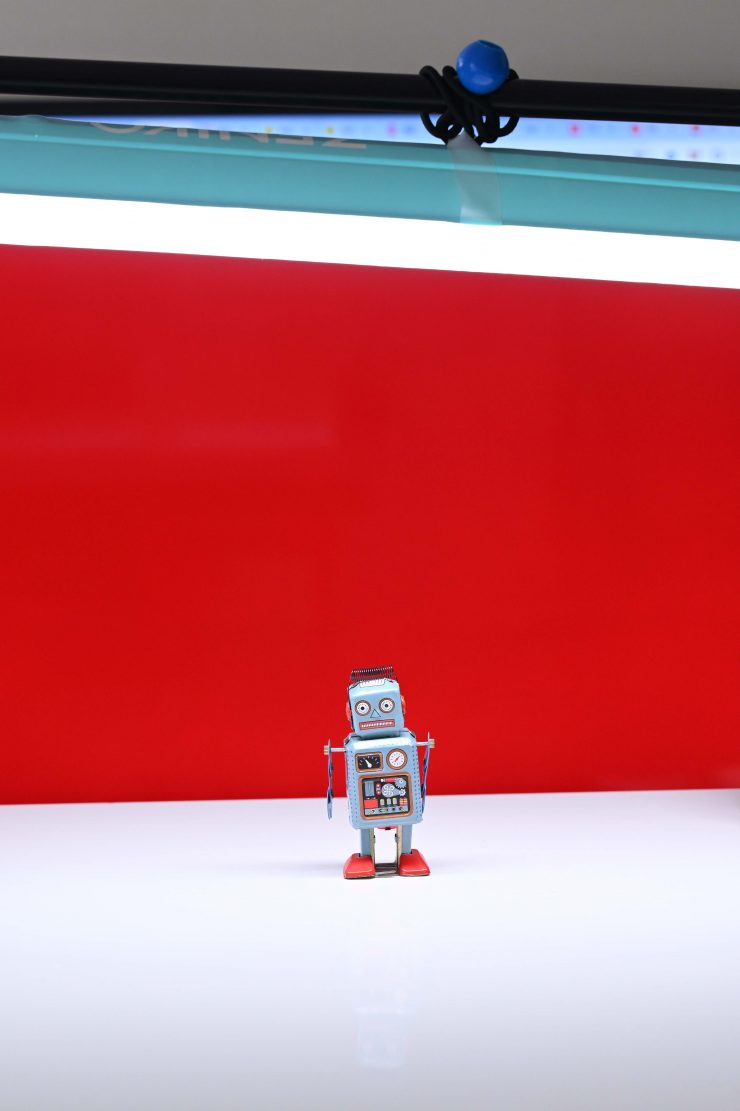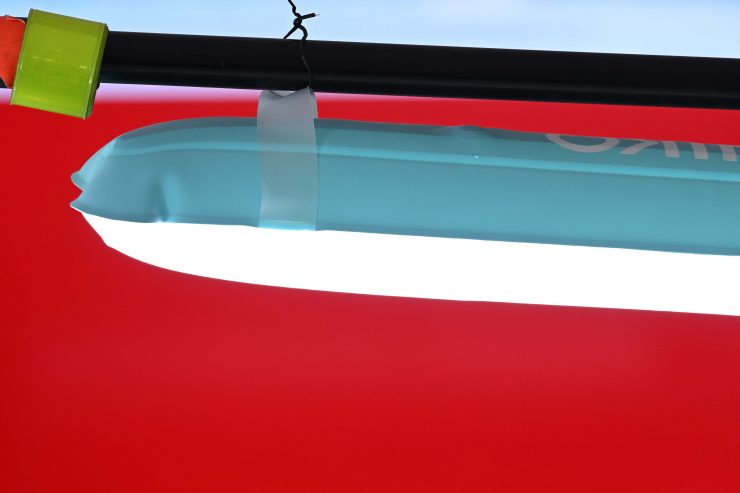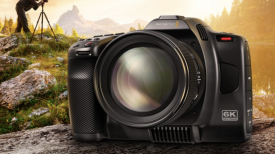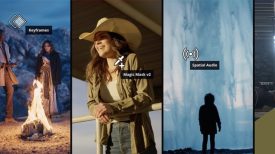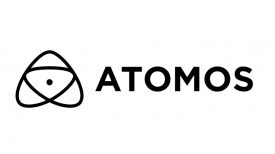
The ZENIKO OT40Bi & OT80Bi Inflatable Tube Lights are being touted as affordable, inflatable, lightweight LED fixtures for content creators.
If you are like me, you have probably never heard of ZENIKO before, but like every item that gets reviewed on Newsshooter, it will get the same thorough and unbiased assessment as any other product. It doesn’t matter to me whether an item costs $20 USD or $20,000 USD, or who makes it.
Essentially, the ZENIKO OT40Bi & OT80Bi Inflatable Tube Lights are compact fixtures that don’t weigh much or take up a lot of space. Before I get started with this review it is important too note that these are not high power draw or high output lights, they are only going to be useful for certain lighting applications.
Size & Weight

The OT40Bi & OT80Bi weigh 129g / 4.55 oz and 185g / 6.52 oz respectively. They roll up the you are not using them so they literally don’t take up much space at all.

The OT40Bi is 40cm / 15.7″ long and the OT80Bi is 80cm / 31.49″ long.
For content creators the small size and weight make them good options, especially for anyone who wants to carry around minimal equipment.
Build Quality
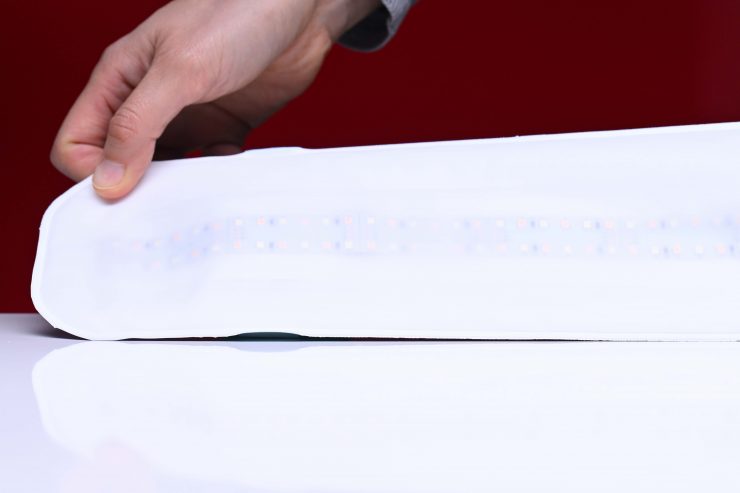
The build quality is ok considering what they are. For inflatable, low-cost fixtures like these, there is nothing I found that overly concerned me. ZENIKO states that the material features an abrasion-resistant design.
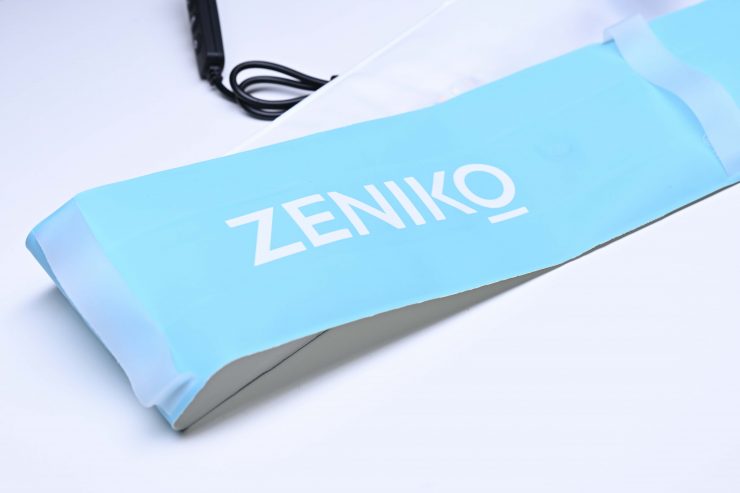
It almost looks like a device you would see at a doctors office for taking your blood pressure.
How do you inflate it?
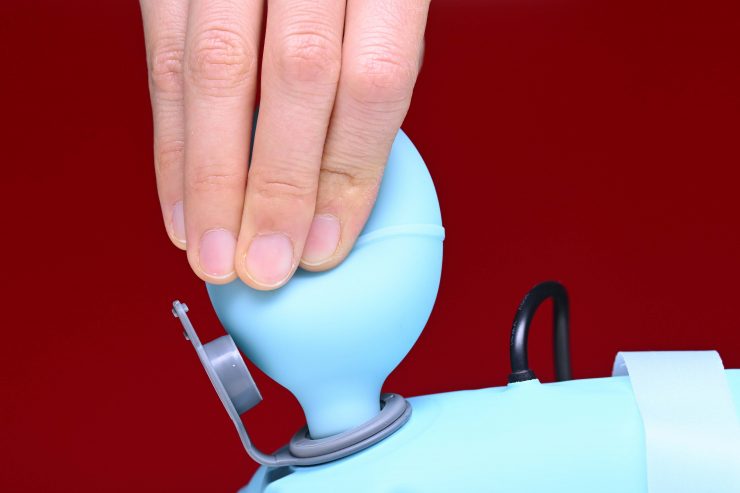
You can inflate both lights by using the included small pump, or you can just blow it up with your mouth.

The valve allows you to easily deflate the lights.
As it is made out of a flexible fabric, if you don’t completely blow it up you can bend it and shape it.
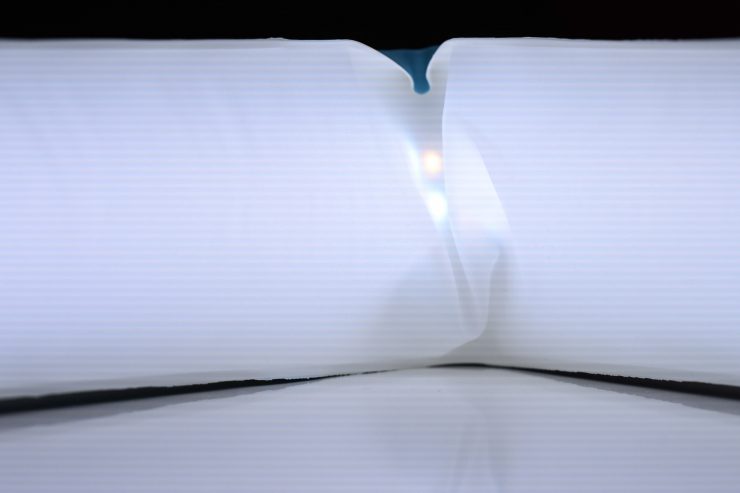
Now, the only problem is that if you don’t inflate it fully and bend it around to create a shape, the diffusion material can end up sitting directly against the LEDs so you get a much harsher light source and hatched shadows. I wouldn’t recommend using it like this as I didn’t think the results you can obtain are very good.
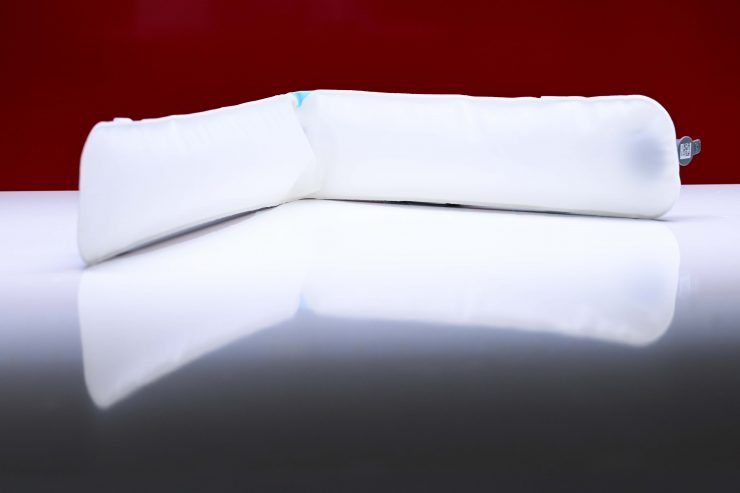
If you half to 2/3 inflate it then you can still slightly bend it to get better results.
How is it powered?
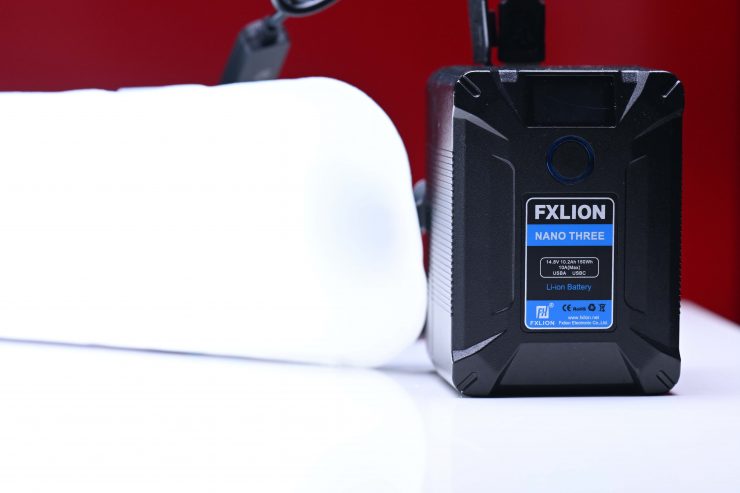
The lights have a built in cable with a regular USB-A connector at the other end. This is somewhat limiting as you need to power the lights via a power bank or a battery that can provide 5V 1A for the OT40Bi or 5V 2A for the OT80Bi.
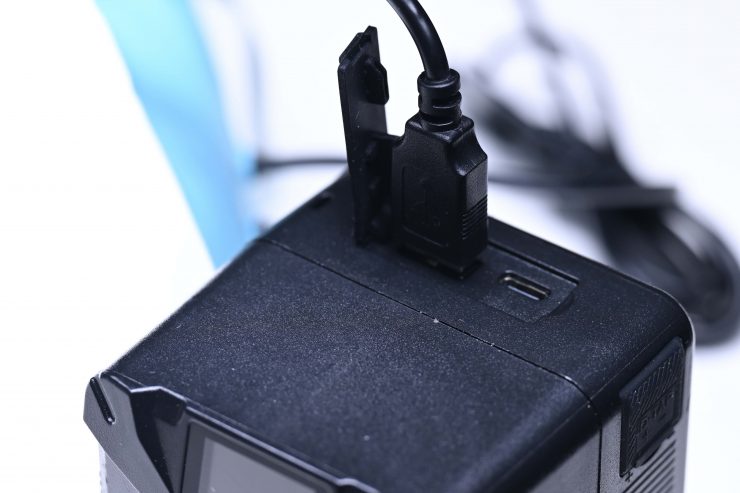
I personally would have preferred to have seen a USB-C connector as way more devices now have USB-C outputs and not USB-A.
Waterproof
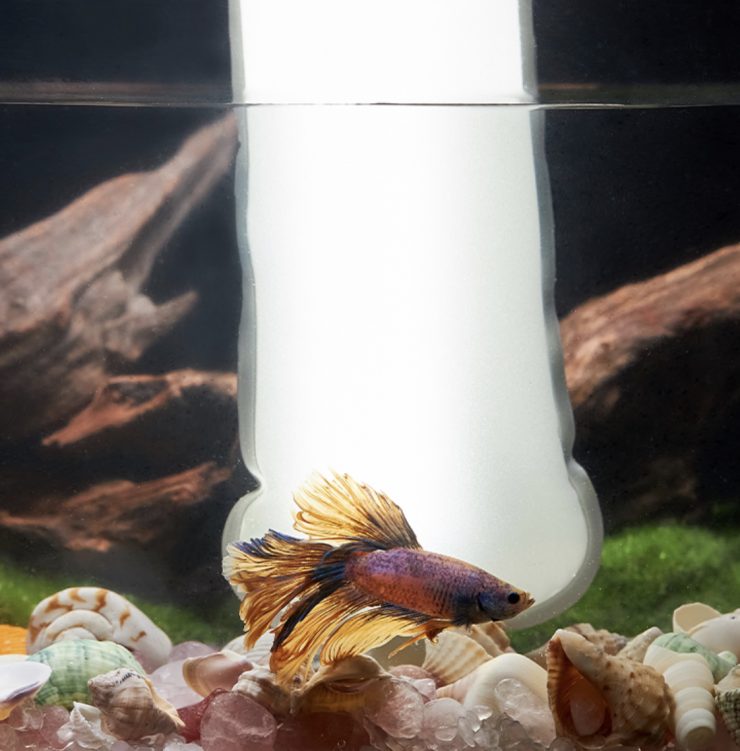
What is handy is that the fixture is waterproof so you can submerge it. Now, you have to be careful, because the power cable isn’t waterproof. This ability does allow you to use the light in water or liquids which can be handy sometimes.
Controls
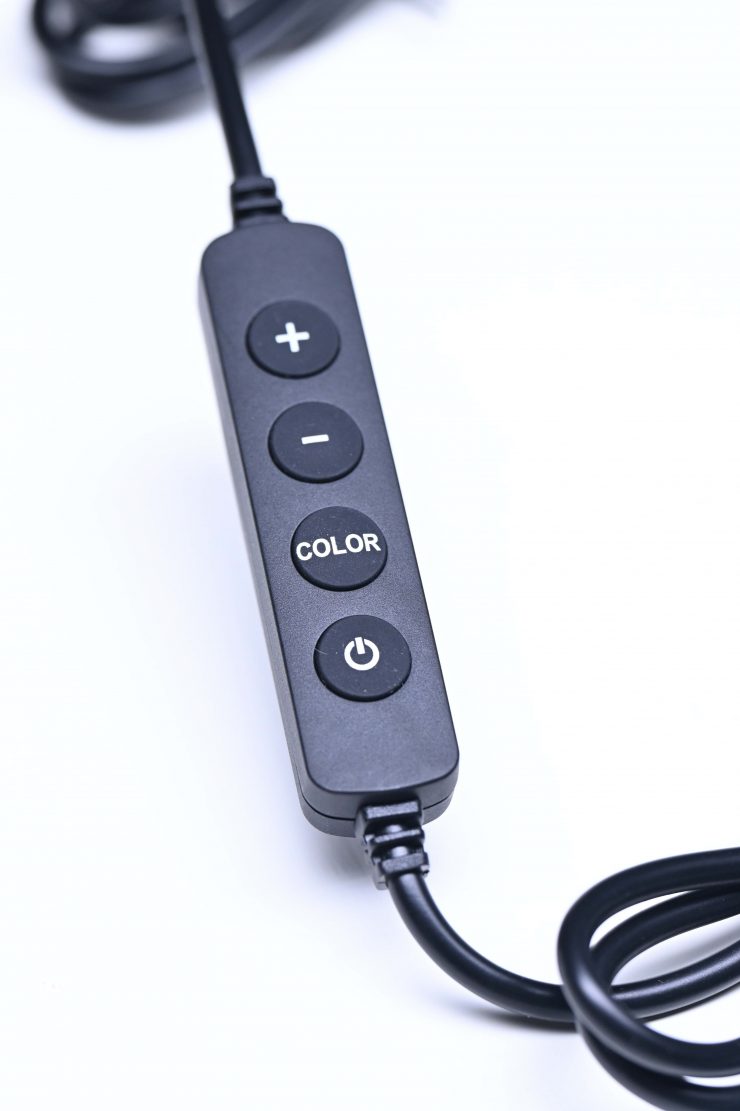
Both fixtures feature very basic controls. There is a small controller on he cable that allows you to change the brightness, intensity and to turn it on/off.
You can change the CCT to the following settings:
- 3000K
- 3800K
- 4600K
- 5600K
- 6500K
It is a little strange that there is no 3200K option. Having the ability to only use 5 pre-defined CCT settings in a bit limiting.
As far as the brightness is concerned, again, you can only choose from the following:
- 10%
- 20%
- 30%
- 40%
- 50%
- 60%
- 70%
- 80%
- 90%
- 100%
The other issue with the controller is that because it doesn’t have any display on it you have no idea what CCT or output is set to.
Set-Up Time & Usability
Both the OT40Bi and OT80Bi are very quick and easy to set-up and use. It takes less than 30 seconds to inflate them and as soon as you plug them into a compatible power supply you just turn them on and you are ready to go.
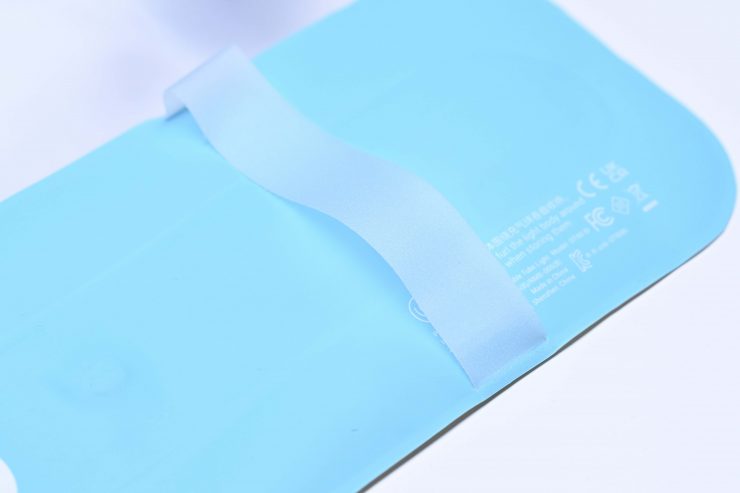
Mounting is a bit of a caveat with these type of lights. There are two tabs on the back of the fixtures that you can run something through, however, they aren’t big enough to put a lot of things through, especially when the lights are inflated.
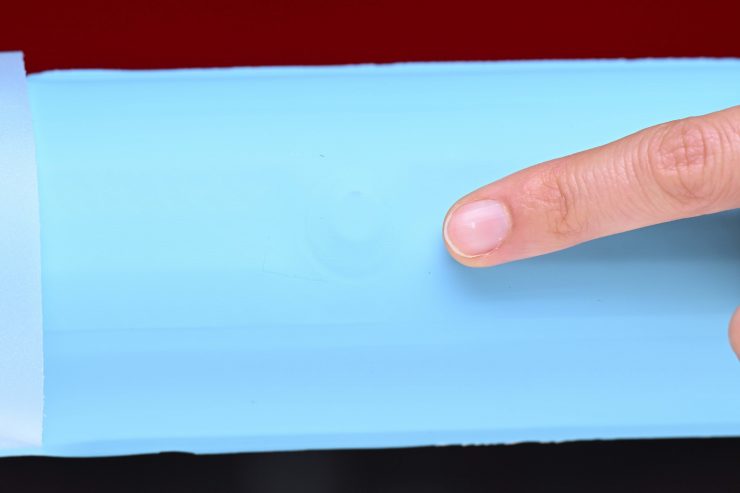
On the positive side, there are two strong magnets on the back of the fixtures so you can attach them to metal objects.

They really are designed so that you need to hold them or place them on a table, etc.
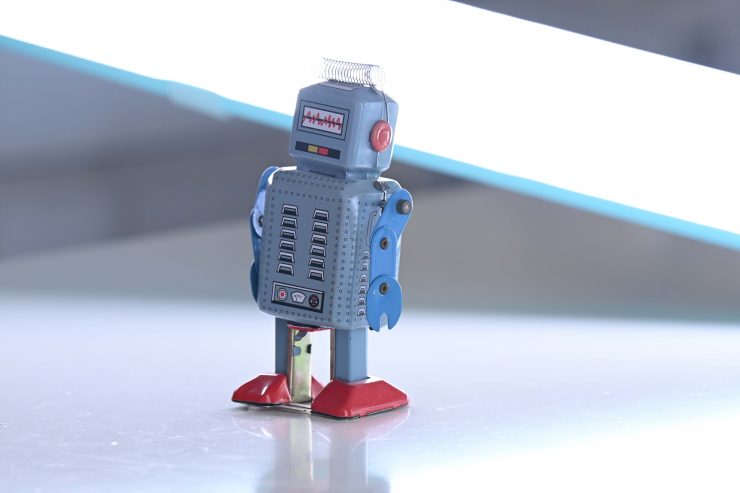
For table top shoots or for situations where you just need a small bit of ambient fill in controlled environments they work reasonably well.
You could also use them as accent lights as long as you are able to hide the power source.

Look, they aren’t going to be lights that are going to suit a lot of peoples needs, but they are handy to have sitting in a kit because they don’t take up any space.
Photometrics
The photometric quality of LED lights is no longer what separates good and bad fixtures. All LED lights, regardless of their price or who makes them, perform well when it comes to color rendering scores. You might be surprised to know that a $20 LED light can have just as good color rendering scores as a $1,000 LED light. What separates lights theses days is build quality, dimming performance, consistent output across the CCT range, accessories, form factor, and usability.
Output & Color Temperature Accuracy
A big factor for a lot of people when buying a light is how much output it can produce.
I tested both light’s output at a variety of CCT settings using a Sekonic C-800 at a distance of 1m (3.28ft) in a controlled environment; you can see the results below.

Above you can see what ZENIKO quotes as the output for the fixtures when used at 5600K at a variety of distances. As you can see these claimed outputs are pretty low
ZENIKO OT40 Bi 5600K
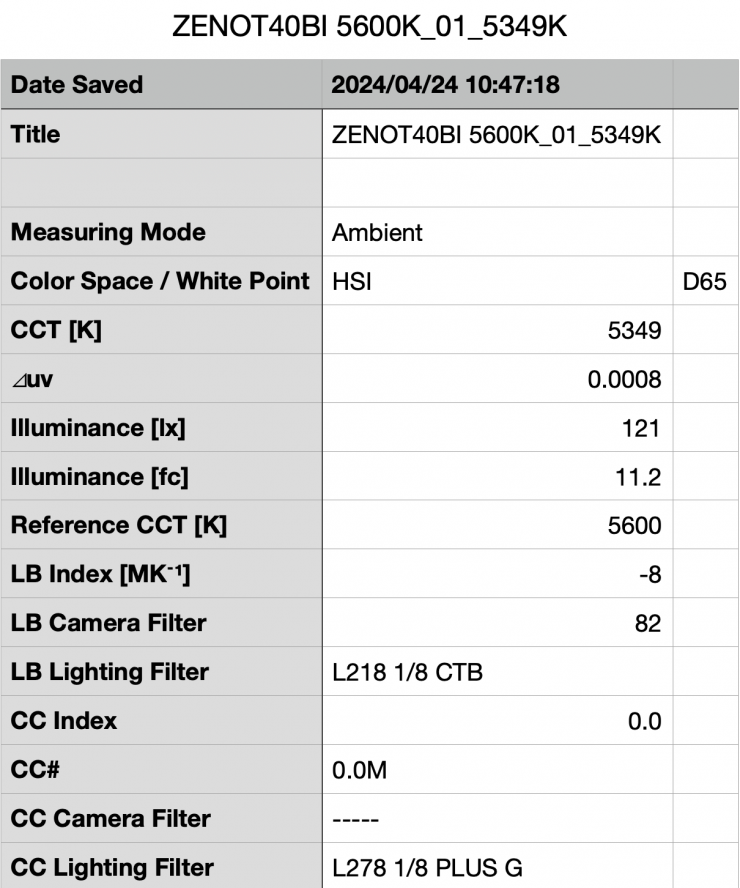
Above you can see that the ZENIKO OT40 Bi recorded an output of 121 lx (11.2 fc) when set at 5600K. 121 lx from an LED light of this size and with a power draw of just 5W is pretty decent.
The reading of 121 lx that I obtained was a little bit higher than the claimed output of 110 lx.
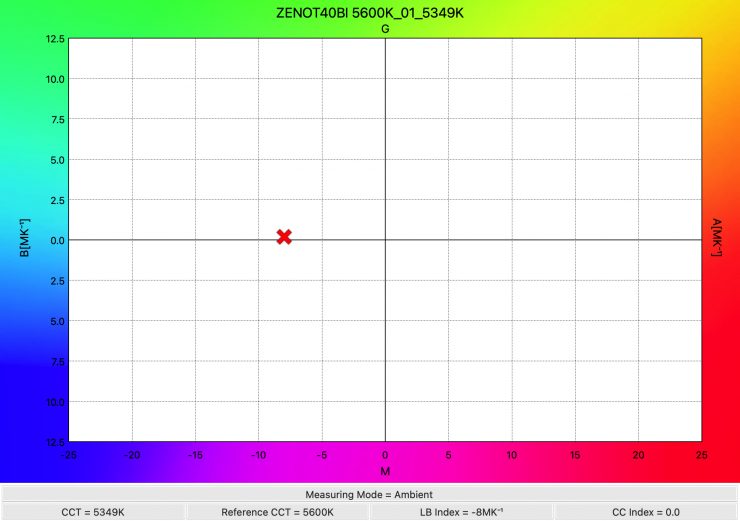
The ZENIKO OT40 Bi produced a CCT reading of 5349K, was not great and it was more than 250K from being correct.
ZENIKO OT80 Bi 5600K

Above you can see that the ZENIKO OT80 Bi recorded an output of 222 lx (20.7 fc) when set at 5600K. 222 lx from an LED light of this size and with a power draw of just 10W is decent.
The reading of 222 lx that I obtained was a little bit less than the claimed output of 230 lx.
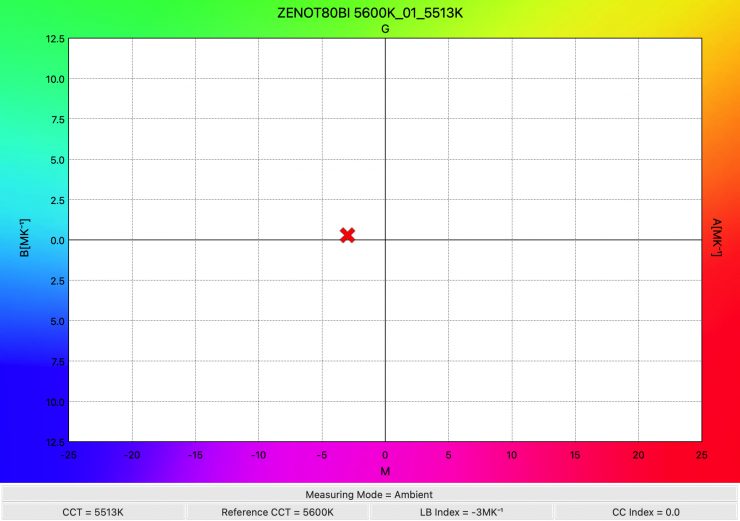
The ZENIKO OT80 Bi produced a CCT reading of 5513K, which was a pretty good reading and a lot better than the reading I got from the OT40 Bi.
ZENIKO OT40Bi 3000K

Above you can see the ZENIKO OT40Bi recorded an output of 109 lx (10.1 fc) when set at 3000K. This was 9.9% less than it produced at 5600K
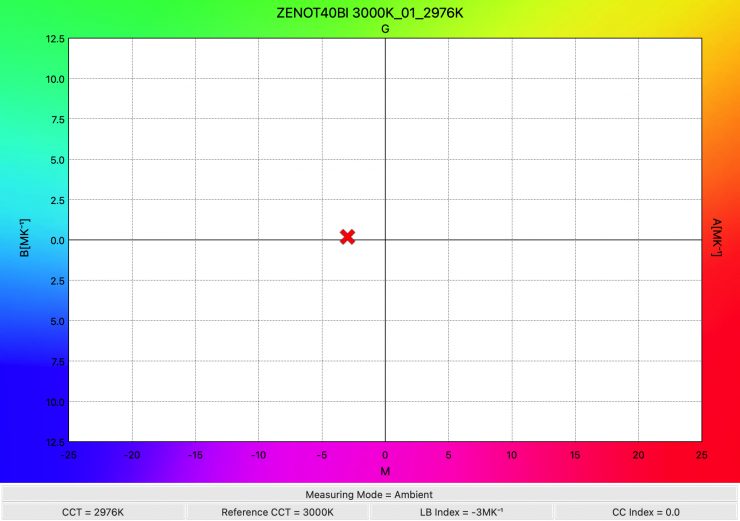
The ZENIKO OT40 Bi produced a CCT reading of 2976K, which was an excellent result
ZENIKO OT80 Bi 3000K
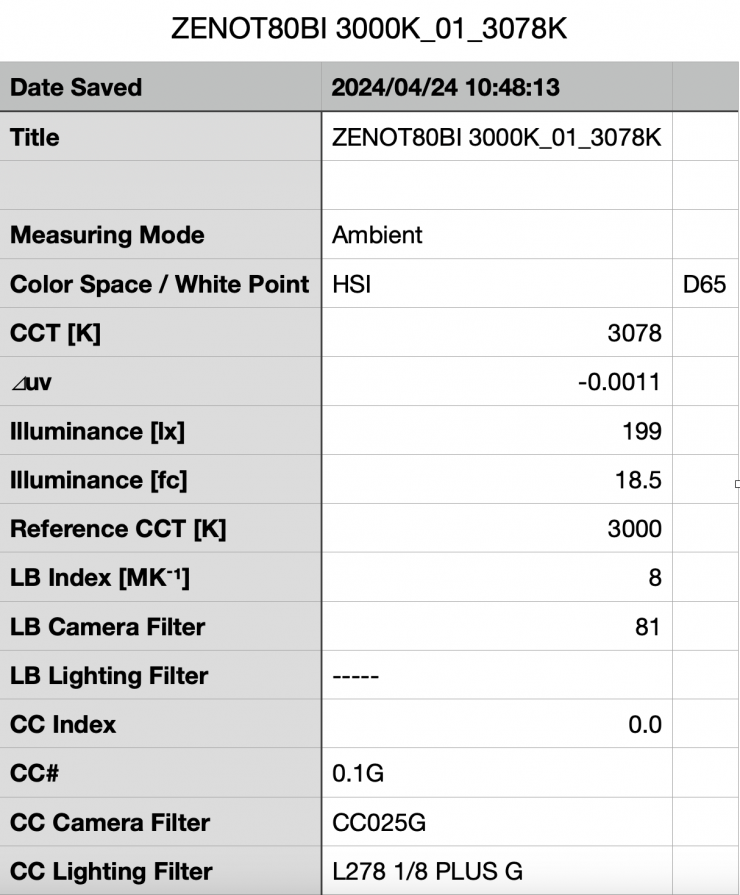
Above you can see the ZENIKO OT80 Bi recorded an output of 199 lx (18.5 fc) when set at 3000K. This was 10.36% less than it produced at 5600K
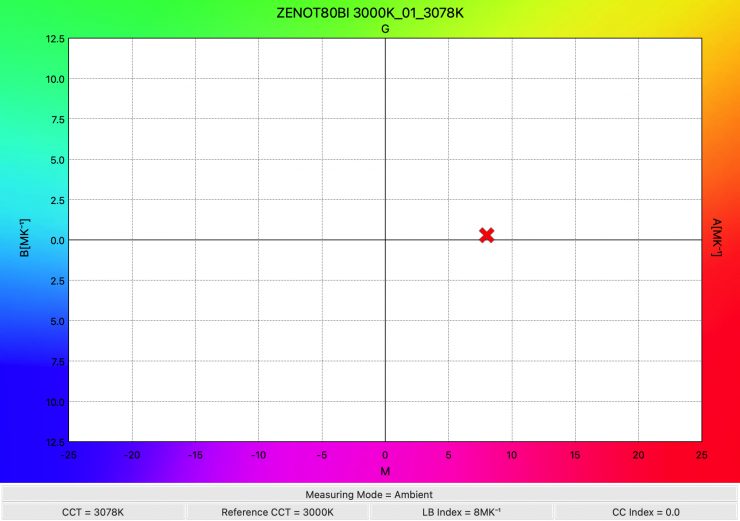
The ZENIKO OT80Bi produced a CCT reading of 3078K, which was a good result.
How does it perform at various CCT settings?
ZENIKO OT40 Bi
| OUTPUT | CCT | |
| 3000K | 109 lx | 2976K |
| 3800K | 112 lx | 3805K |
| 4600K | 118 lx | 4469K |
| 5600K | 121 lx | 5349K |
| 6500K | 128lx | 6057K |
The light’s output was reasonably consistent across its CCT range. The output across its CCT range varied by 14.84%. While there is nothing wrong with having a higher output at certain CCT settings, on really good lights the output is almost identical no matter what CCT setting you select.
The results also show me that the light is pretty accurate when it comes to CCT reproduction from 3000-4600K. At 5600K it was off by more than 250K, and at 6500K itv was off by over 400K. The CCT was excellent at 3000K, 3800K, and 4500K.
ZENIKO OT80 Bi
| OUTPUT | CCT | |
| 3000K | 199 lx | 3078K |
| 3800K | 206 lx | 3884K |
| 4600K | 216 lx | 4599K |
| 5600K | 222 lx | 5513K |
| 6500K | 227 lx | 6274K |
The light’s output wasn’t pretty consistent across its CCT range. The output across its CCT range varied by 12.33%.
The results also show me that the light is pretty accurate when it comes to CCT reproduction from 3000-5600K. At 6500K it was off by 226K. The CCT was almost perfect at 4600K.
CCT consistency & linear output when dimming the lights
Now, what you should always do when testing lights is to see if the CCT remains consistent when dimming the light. Just because you set a light at say 5600K, that doesn’t mean that the CCT will remain stable as you start dimming the fixture down. I also wanted to see how linear the dimming curve was.
I decided to do a series of tests at 100%/70%/50%/20%10% to see if the CCT being recorded changed. This was done at a distance of 1m / 3.3′ using a Sekonic C-800. These tests were done at 5600K.
ZENIKO OT40 Bi
| CCT READING | OUTPUT | INTENSITY % |
| 5349K | 121 lx | 100 |
| 5961K | 105 lx | 70 |
| 5926K | 80.8 lx | 50 |
| 5795K | 44.7 lx | 20 |
| 5640K | 31.6 lx | 10 |
The ZENIKO OT80 Bi didn’t maintain good CCT consistency as you start dimming the fixture down, in fact, the results were all over the place. Ironically the light had its best CCT result at 5600K when set to 10% output. My testing showed that the CCT readings varied by 577K.
As far as how linear the output is when you start dimming the light, at 50% output it had 33.22% less output than when used at 100%. At 20% it had 63% less output than when used at 100%. At 10% output, it had 73.88% less output than when used at 100%. This shows me that the light’s dimming curve is not al all linear. These were some of the worst results I have seen, however, you do have to remember that this light costs less than $30 USD.
ZENIKO OT80 Bi
| CCT READING | OUTPUT | INTENSITY % |
| 5513K | 222 lx | 100 |
| 5458K | 162 lx | 70 |
| 5528K | 118 lx | 50 |
| 5512K | 52.5 lx | 20 |
| 5249K | 31.1 lx | 10 |
The ZENIKO OT80 Bi maintained good CCT consistency as you start dimming the fixture to 20%. Under 20% the consistency started to waver. My testing showed that the CCT readings varied by 279K from 100% to 10%.
As far as how linear the output is when you start dimming the light, at 50% output it had 46.84% less output than when used at 100%. At 20% it had 76.35% less output than when used at 100%. At 10% output, it had 85.99% less output than when used at 100%. This shows me that the light’s dimming curve is reasonably linear, and a lot better than that of the OT40 Bi.
Color Rendering
So now that we have seen how much output the fixtures produced, how do they perform when it comes to replicating accurate colors?
ZENIKO OT40 Bi 5600K

Above you can see that when the light was set at 5600K it recorded an average CRI (R1-R8) of 98.1 and an extended CRI (R1-R15) of 96.80. For replicating accurate skin tones it recorded 96.8 for R9 (red), 99.4 for R13 (closest to caucasian skin tones), and 98.2 for R15 (closest to Asian skin tones). These were excellent results, and only R12 (Blue) was below 90.
This is why you should never judge a book by its cover, or in this case, a light by its price and brand.
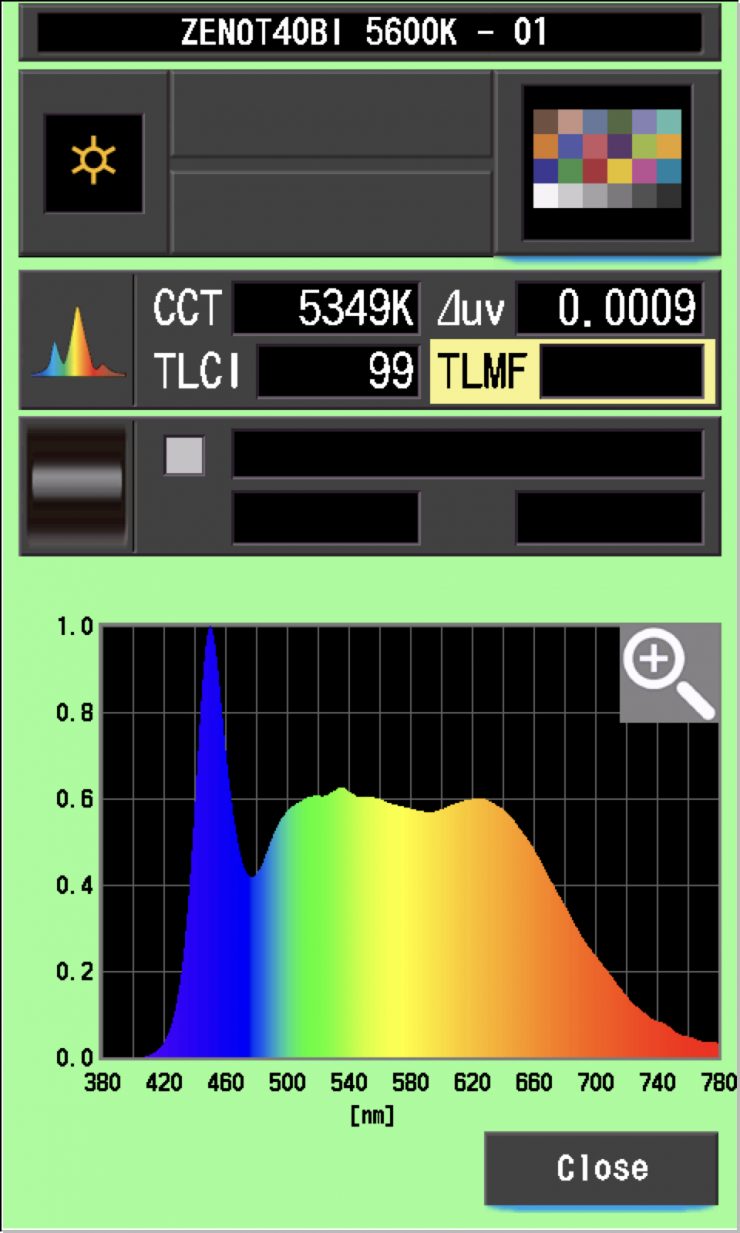
The light when set at 5600K also recorded a TLCI score of 99.
ZENIKO OT80 Bi 5600K
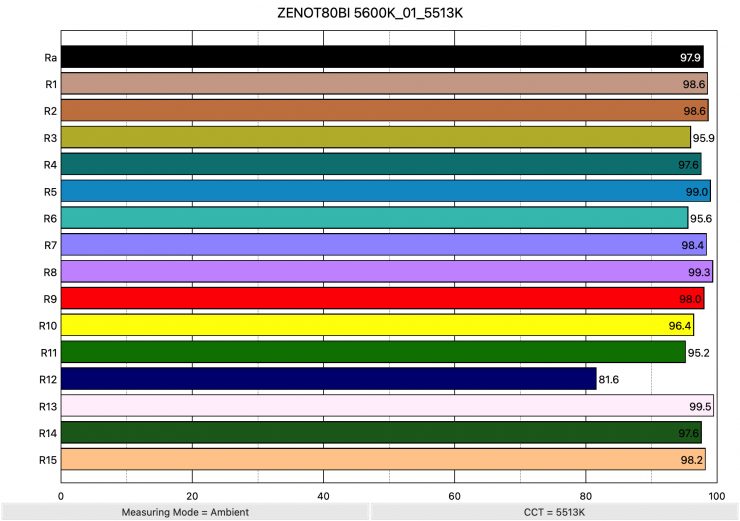
Above you can see that when the light was set at 5600K it recorded an average CRI (R1-R8) of 97.9 and an extended CRI (R1-R15) of 96.63. For replicating accurate skin tones it recorded 98.0 for R9 (red), 99.5 for R13 (closest to caucasian skin tones), and 98.2 for R15 (closest to Asian skin tones). These were excellent results, and only R12 (Blue) was below 90.
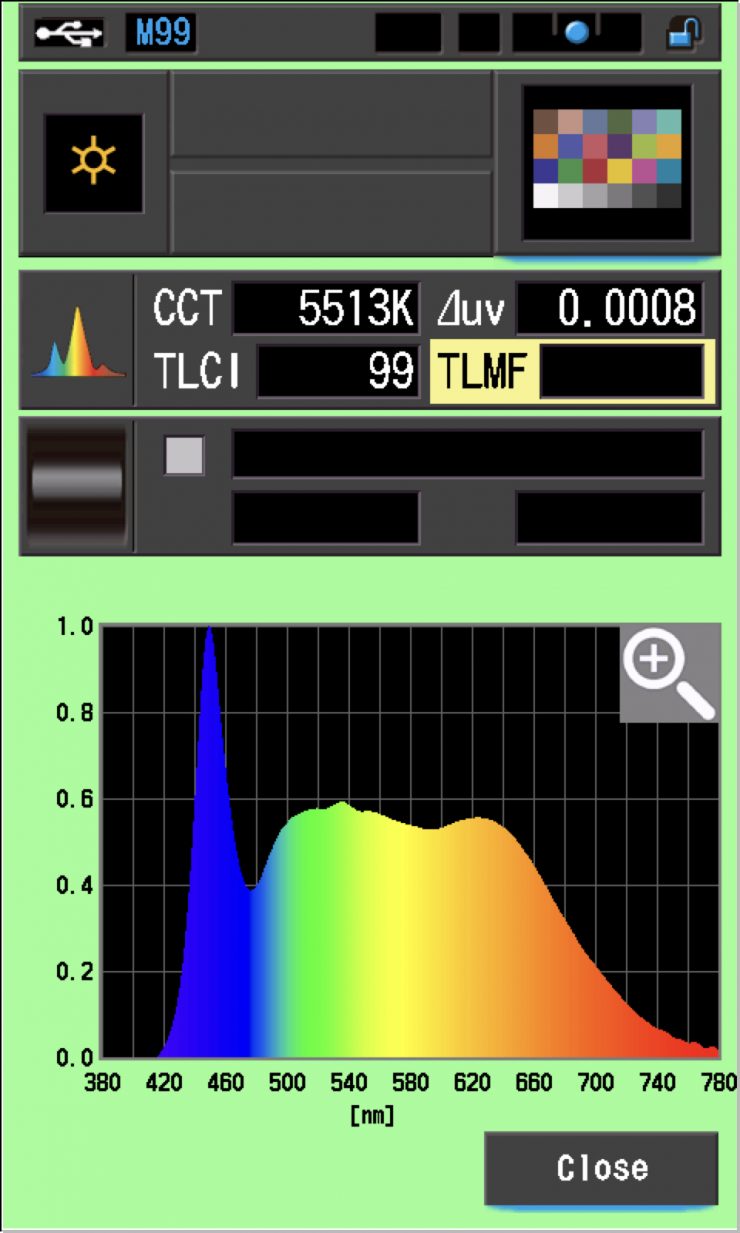
The light when set at 5600K also recorded a TLCI score of 99.
ZENIKO OT40Bi 3000K
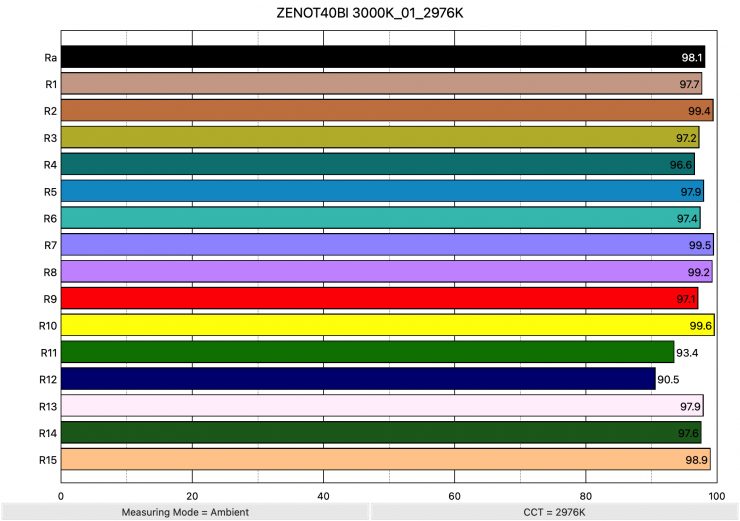
Above you can see the scores for when the light was used at 3000K. It recorded an average CRI (R1-R8) of 98.1 and an extended CRI (R1-R15) of 97.32. For replicating accurate skin tones it recorded 97.1 for R9 (red), 97.9 for R13 (closest to caucasian skin tones), and 98.9 for R15 (closest to Asian skin tones). Just like at 5600K, these were excellent results, and no value was below 90.
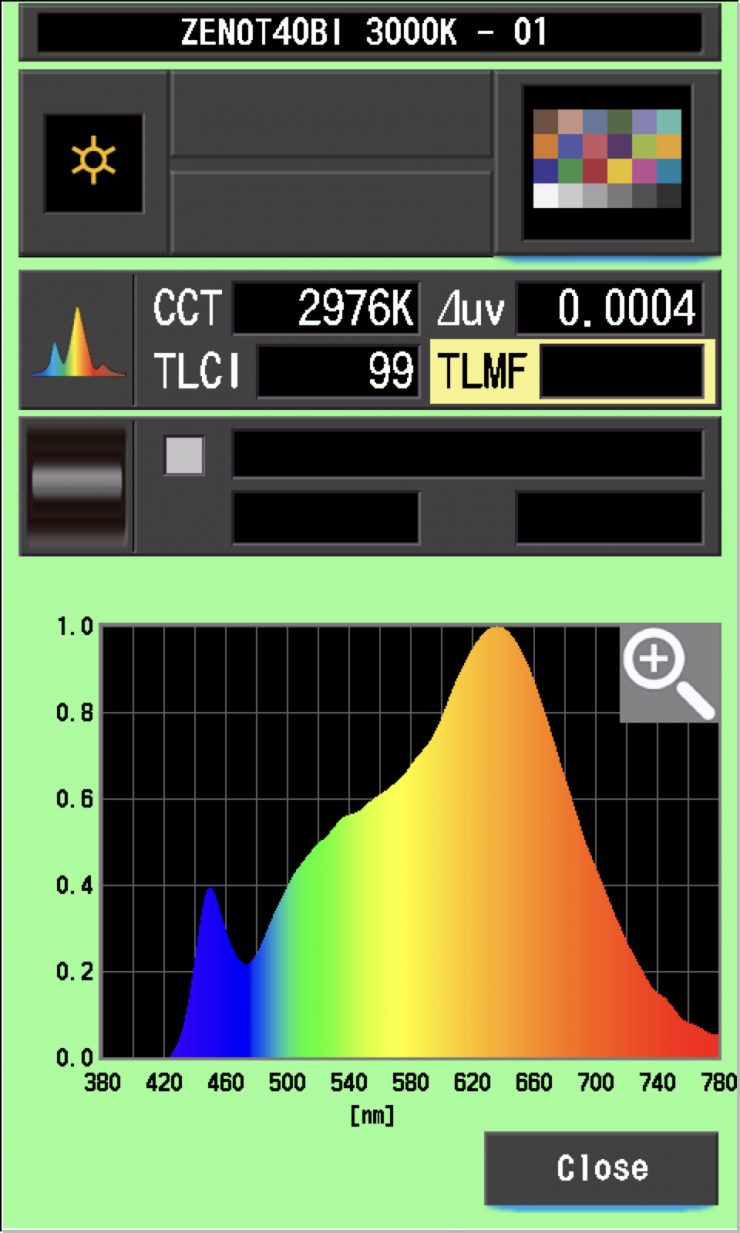
The light when set at 3000K also recorded a TLCI score of 99.
ZENIKO OT80 Bi 3000K
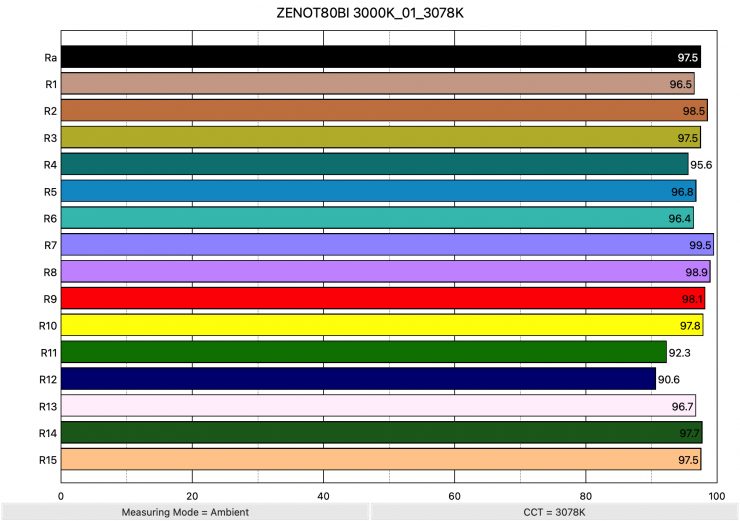
Above you can see the scores for when the light was used at 3000K. It recorded an average CRI (R1-R8) of 97.5 and an extended CRI (R1-R15) of 96.69. For replicating accurate skin tones it recorded 98.1 for R9 (red), 96.7 for R13 (closest to caucasian skin tones), and 97.5 for R15 (closest to Asian skin tones). Just like at 5600K, these were excellent results, and not one value was below 90.
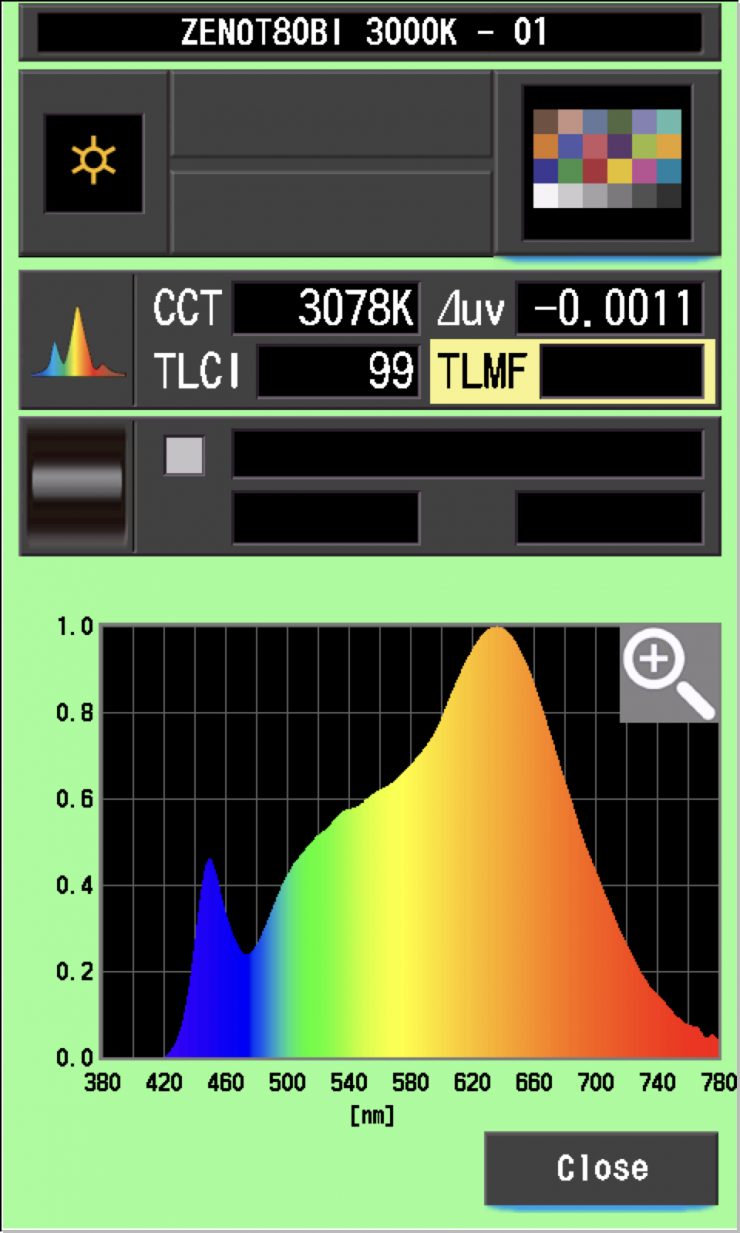
The light when set at 3000K also recorded a TLCI score of 99.
CC Index & ⊿uv
The CC Index displays the CC correction value and whether any magenta or green need to be added or subtracted. 1 CC corresponds to 035 Kodak CC values or 1/8 Rosco filter values. Any reading less than +1.00 or -1.00 and you’re probably not going to need to make any kind of adjustment. The ⊿uv is the value to show how much this light is away from being an ideal light source (black body radiation = incandescent lamp). As with the CC Index you want this number to theoretically be zero. Kelvin is not a linear value, so we need to convert from Kelvin to MK-1 to compare the values of color temperature. To calculate from Kelvin to Mired is MK-1= 1*1000000/Kelvin. While this may sound confusing, it is the only way of measuring if the Kelvin shift is significant enough to warrant having to use a filter for correction. Below are the results for the ZENIKO fixtures:
ZENIKO OT40 Bi Vs MK-1
| Kelvin | Difference in K | MK-1 | Difference in MK-1 | |
| SET VALUE | 3000K | 0 | 333.33 | 0 |
| ACTUAL READING | 2976K | 24 | 336.02 | -2.69 MK-1 |
| SET VALUE | 3800K | 0 | 263.15 | 0 |
| ACTUAL READING | 3805K | 5 | 262.81 | 0.34 MK-1 |
| SET VALUE | 4600K | 0 | 217.39 | 0 |
| ACTUAL READING | 4469K | 131 | 226.73 | -9.34 MK-1 |
| SET VALUE | 5600K | 0 | 178.57 | 0 |
| ACTUAL READING | 5349K | 251 | 186.95 | -8.38 MK-1 |
| SET VALUE | 6500K | 0 | 153.84 | 0 |
| ACTUAL READING | 6057K | 443 | 165.09 | -11.25 MK-1 |
These figures might look confusing, but what they tells me is that the light is very CCT-accurate at 3000K and 3800K, however, above 3800K it is pretty bad. Any MK-1 score that is under -9/9 means you wouldn’t have to use any color correction gels. The MK-1 scores for this light were a mixed bag. Any MK-1 score that is under -6/6 is a very good result. At 3800K the score was almost perfect.
ZENIKO OT80 Bi Vs MK-1
| Kelvin | Difference in K | MK-1 | Difference in MK-1 | |
| SET VALUE | 3000K | 0 | 333.33 | 0 |
| ACTUAL READING | 3078K | 78 | 324.88 | 8.45 MK-1 |
| SET VALUE | 3800K | 0 | 263.15 | 0 |
| ACTUAL READING | 3884K | 84 | 257.46 | 5.69 MK-1 |
| SET VALUE | 4600K | 0 | 217.39 | 0 |
| ACTUAL READING | 4599K | 1 | 217.43 | -0.04 MK-1 |
| SET VALUE | 5600K | 0 | 178.57 | 0 |
| ACTUAL READING | 5513K | 87 | 186.95 | 5.57 MK-1 |
| SET VALUE | 6500K | 0 | 153.84 | 0 |
| ACTUAL READING | 6274K | 226 | 159.38 | -5.54MK-1 |
These figures might look confusing, but what they tells me is that the light is reasonably CCT-accurate across its range. Any MK-1 score that is under -9/9 means you wouldn’t have to use any color correction gels. Any MK-1 score that is under -6/6 is a very good result. At 4600K the score was almost perfect.
Ok, now let’s look at the CC INDEX & ⊿uv.
ZENIKO OT40 Bi CC INDEX & ⊿uv
| CC INDEX | ⊿uv | |
| 3000K | 0.2M | 0.0004 |
| 3800K | 0.1G | -0.0025 |
| 4600K | 0.2G | -0.0015 |
| 5600K | 0.0 | 0.0008 |
| 6500K | 0.1M | 0.0035 |
These were very good results. The ⊿uv scores at all CCT values were reasonably good, and the CC Index scores in particular, were very consistent.
ZENIKO OT80 Bi CC INDEX & ⊿uv
| CC INDEX | ⊿uv | |
| 3000K | 0.1G | -0.0011 |
| 3800K | 0.2G | -0.0032 |
| 4600K | 0.1G | -0.0020 |
| 5600K | 0.0 | 0.0008 |
| 6500K | 0.1M | 0.0035 |
These were outstanding results. The ⊿uv scores at all CCT values were reasonably good, and the CC Index scores in particular, were some of the best I have seen.
TM-30
TM-30 is a relatively new color rendering standard that was developed to deal with the limitations of CRI. TM-30 looks at 99 individual colors. These 99 colors are categorized into seven groups: nature, skin color, textiles, paints, plastics, printed material, and color systems.
TM-30 scores go from 0 – 100. The higher the score, the more accurate a light is at producing colors. Any TM-30 Rf score in the ’90s is considered to be good. What is interesting and something that you need to be very aware of is that two separate light sources with the exact same CRI scores can render colors very differently. A light with a high CRI rating could have a low TM-30 score. Conversely, a light with a good TM-30 score could have a bad CRI score.
Now, there are two measurements associated with TM-30, Rf and Rg.
Rf (Color Fidelity)
Rg (Color Gamut)
With Rf value, ideally, you want a score in the 90’s.
With Rg value, a score below 100 indicates that the light source renders colors with less saturation than the reference source. Any score above 100 means it is over-saturating colors. So ideally you want this score to be 100.
ZENIKO OT40 Bi
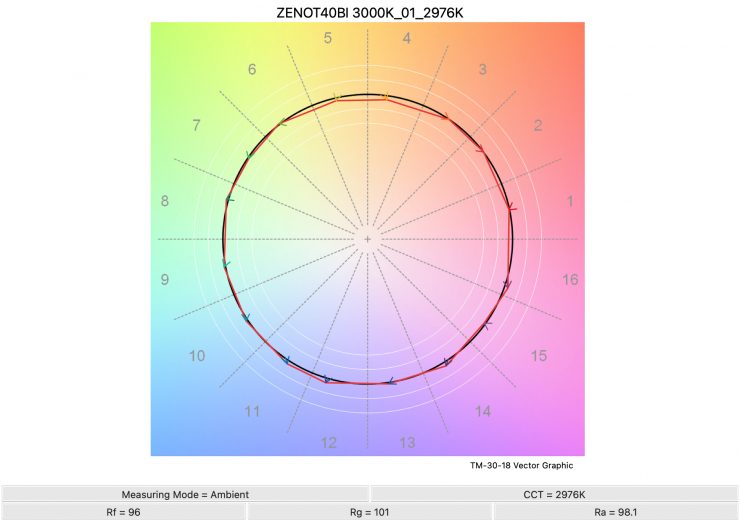

3000K 
3800K 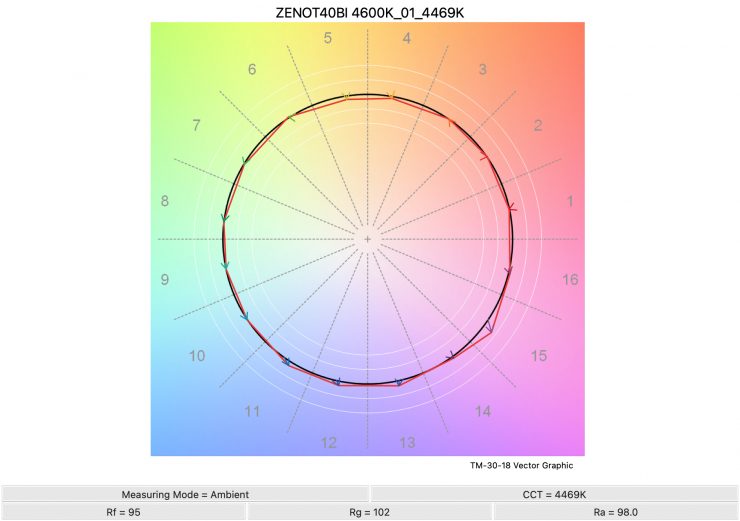
4600K 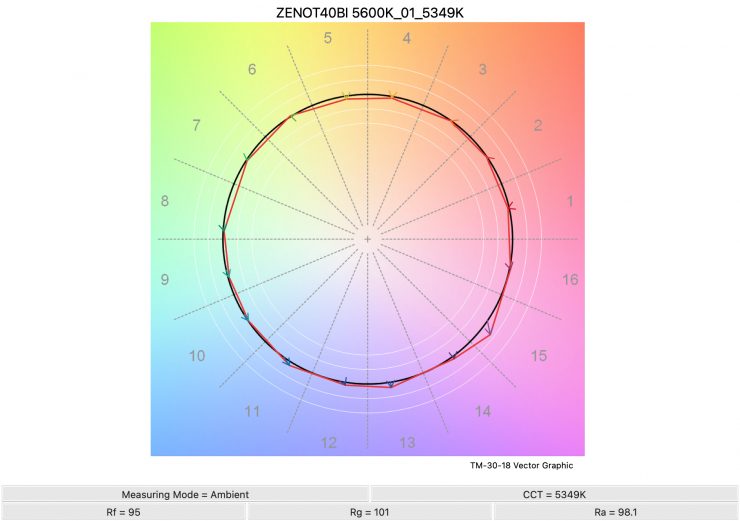
5600K 
6500K
Above you can see the scores for the ZENIKO OT40 Bi at various CCT settings. Below I have listed the figures as well.
Here are the results:
| Rf | Rg | |
| 3000K | 96 | 101 |
| 3800K | 95 | 102 |
| 4600K | 95 | 102 |
| 5600K | 95 | 101 |
| 6500K | 94 | 100 |
The TM-30 scores were very consistent. The light is very good at replicating accurate colors with full saturation.
ZENIKO OT80Bi


3000K 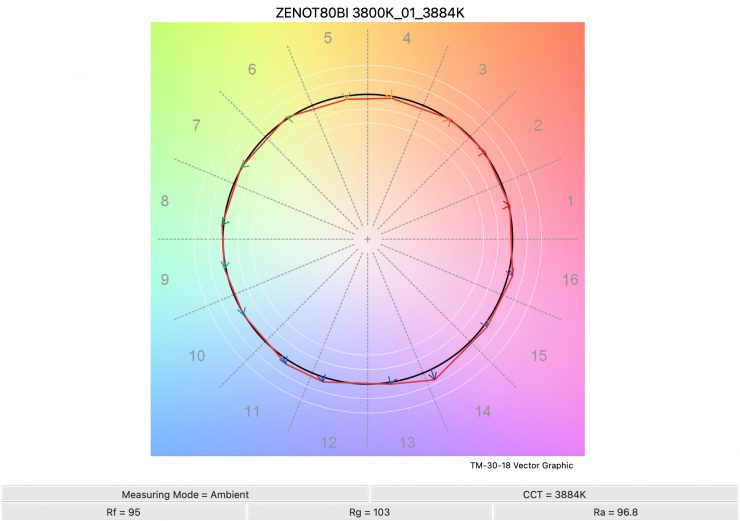
3800K 
4600K 
5600K 
6500K
Above you can see the scores for the ZENIKO OT80 Bi at various CCT settings. Below I have listed the figures as well.
Here are the results:
| Rf | Rg | |
| 3000K | 96 | 102 |
| 3800K | 95 | 103 |
| 4600K | 95 | 103 |
| 5600K | 95 | 102 |
| 6500K | 94 | 100 |
The TM-30 scores were very consistent from 3200-6500K. The light is very consistent at replicating accurate colors with full saturation. However, you can see that it did have a tendency to slightly over-saturate magenta/red colors at 3800 and 4600K.
SSI
SSI (Spectral Similarity Index) was developed by the Sci-Tech Council of the Academy. SSI gives me the ability to set any light as a standard, or use predefined standards (such as CIE D55), and then give other lights an SSI score based upon how well they will match standards such as CIE D55 measure spectral response and compare it directly against an ideal light source.
SSI is a much better way to judge an LED light than CRI or TLCI, although they don’t tell the full story of any light and you can’t judge a light by SSI scores alone.
SSI is useful to see how well different lights will play together. As the Sekonic C-800 Spectromaster can measure SSI, I decided to test out the lights to see how it performed.
ZENIKO OT40 Bi 3000K
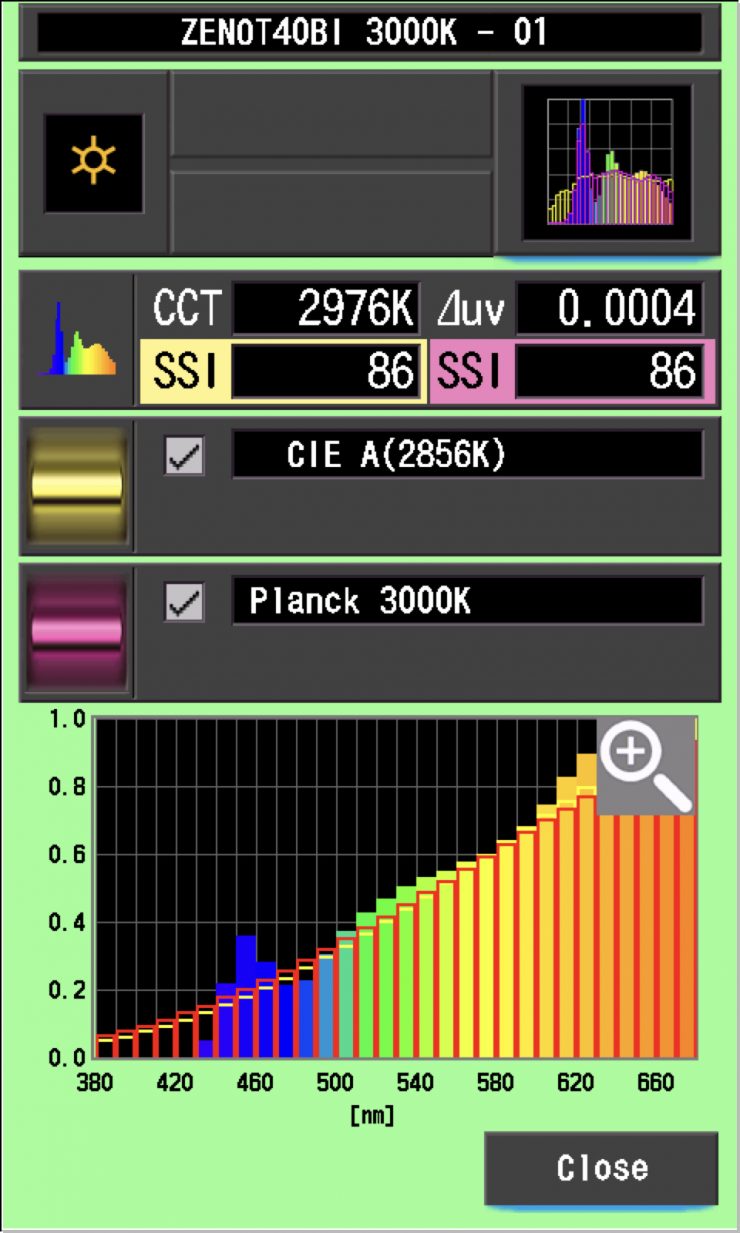
Above are the scores for the light when used at 3000K. The scores show that the light does a very good job of accurately replicating a CIE A (2856K) source. Any score in the mid to high 80’s is outstanding for an LED light.

Above you can see a comparison SSI score from the Nanlite PavoSlim 60C.
ZENIKO OT80 Bi 3000K
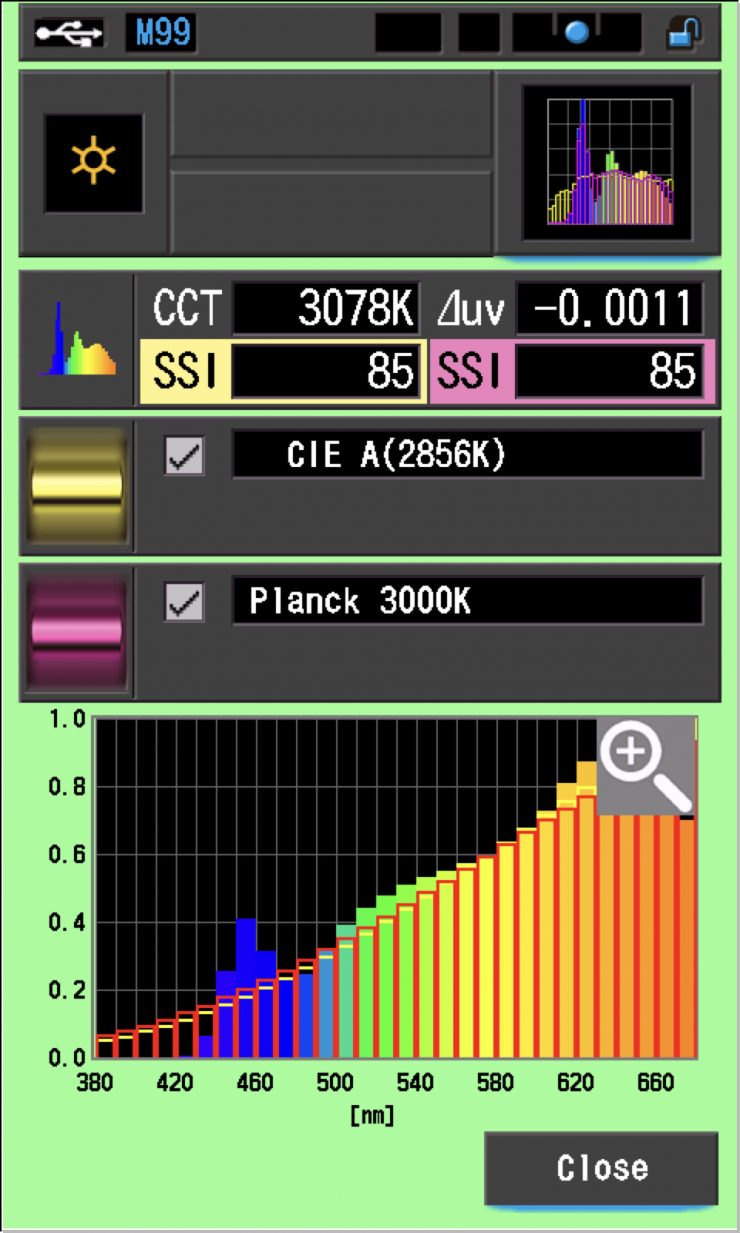
Above are the scores for the light when used at 3200K. The scores show that the light does a very good job of accurately replicating a CIE A (2856K) source. Any score in the mid to high 80’s is outstanding for an LED light.

Above you can see a comparison SSI score from the Nanlite PavoSlim 60C.
ZENIKO OT40 Bi 5600K
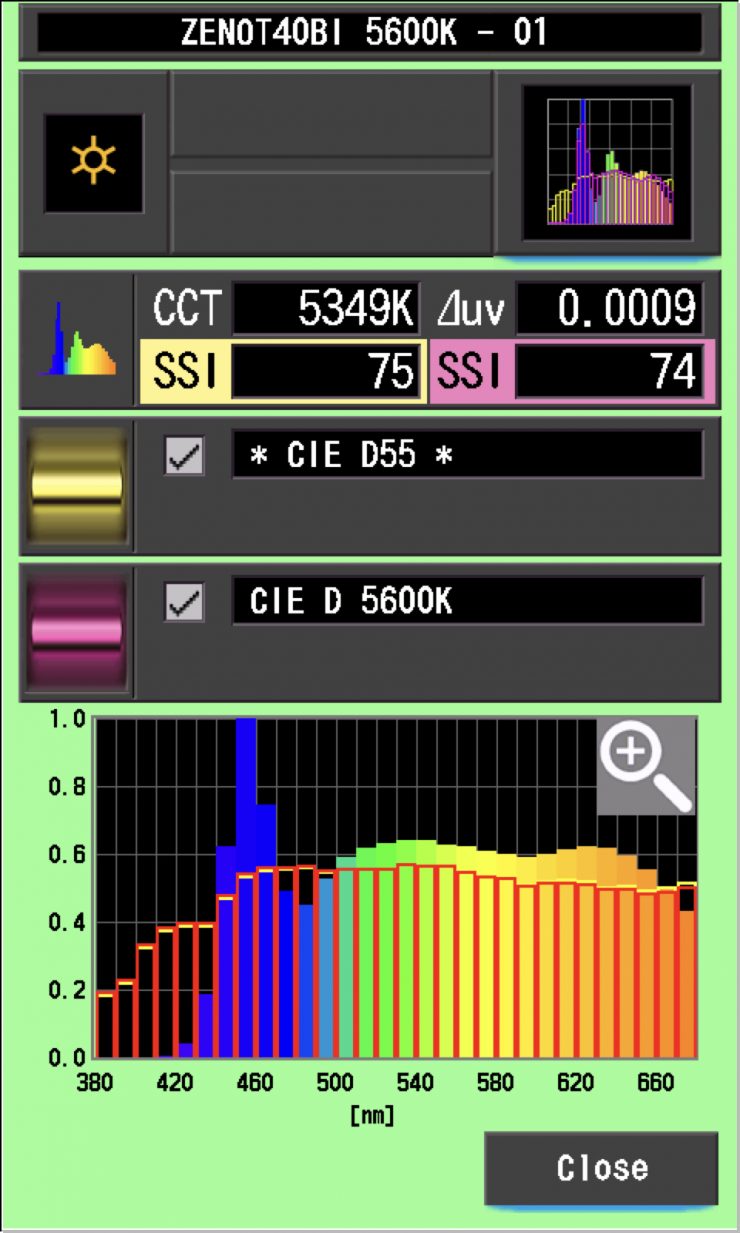
Above are the scores for the light when used at 5600K. The scores show that the light does a reasonably good job of accurately replicating a CIE D55 source. A score in the low to mid-70s is very typical for a 5600K LED light.

Above you can see a comparison SSI score from the Nanlite PavoSlim 60C.
ZENIKO OT80 Bi 5600K
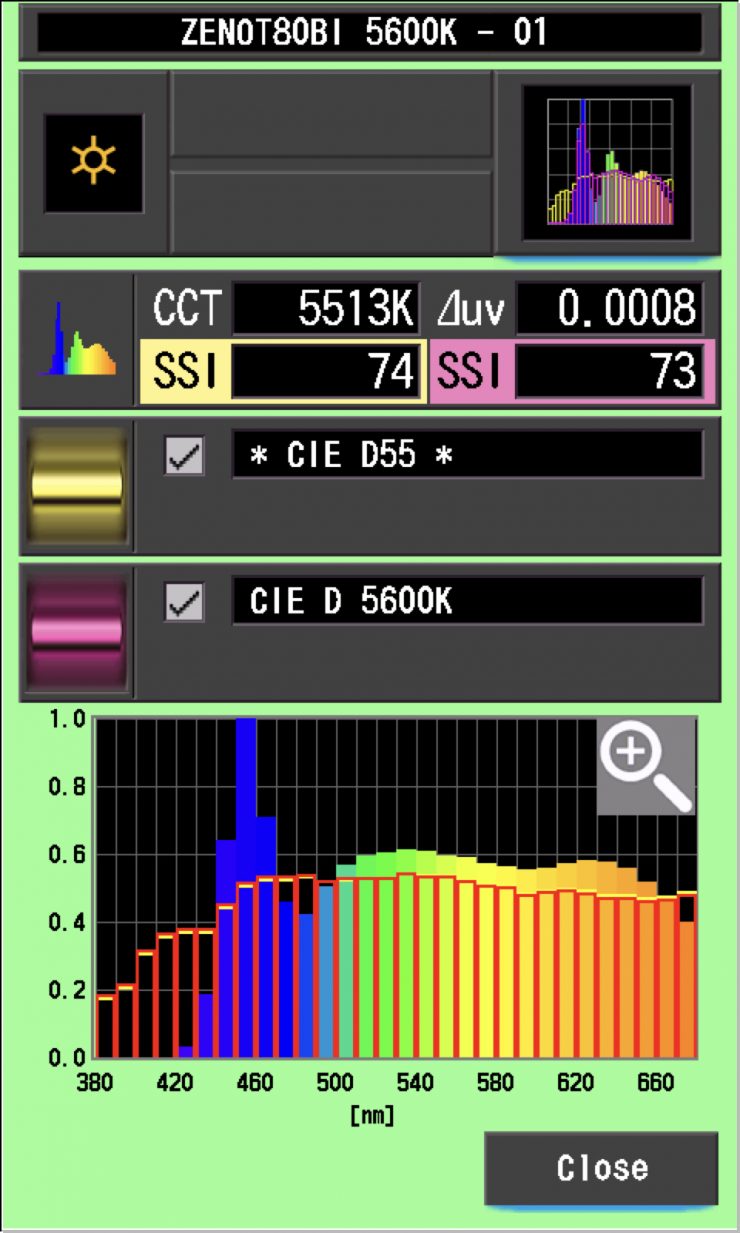
Above are the scores for the light when used at 5600K. The scores show that the light does a reasonably good job of accurately replicating a CIE D55 source. A score in the low to mid-70s is very typical for a 5600K LED light.

Above you can see a comparison SSI score from the Nanlite PavoSlim 60C.
The main reason we want to record SSI scores is so we can see how well they match with other lights. For example, let’s see how well the ZENIKO OT40 Bi matches the OT80 Bi and ARRI Orbiter when used at 5600K. Below you can see the results.
ZENIKO OT40 Bi 5600K

As you can see the ZENIKO OT40 Bi is almost a perfect match to the ZENIKO OT80 Bi when used at 5600K. It is also a decent enough match with the ARRI Orbiter.
Ok, let’s have a look at how well the ZENIKO OT80 Bi matches the ARRI Orbiter and Prolycht Orion 675 when used at 5600K.
ZENIKO OT80 Bi 5600K

At 3200K the ZENIKO OT80 Bi is also a pretty good match to the Prolycht.
Being able to measure SSI in advance and compare different lights you may be using together is a great way of finding out what lights will work together and what adjustments need to be made.
Spectral Distribution
ZENIKO OT40 Bi 3000K

Above you can see the spectral distribution of the ZENIKO OT40 Bi when it is set at 3000K. The spectral distribution is pretty good.
ZENIKO OT80 Bi 3000K
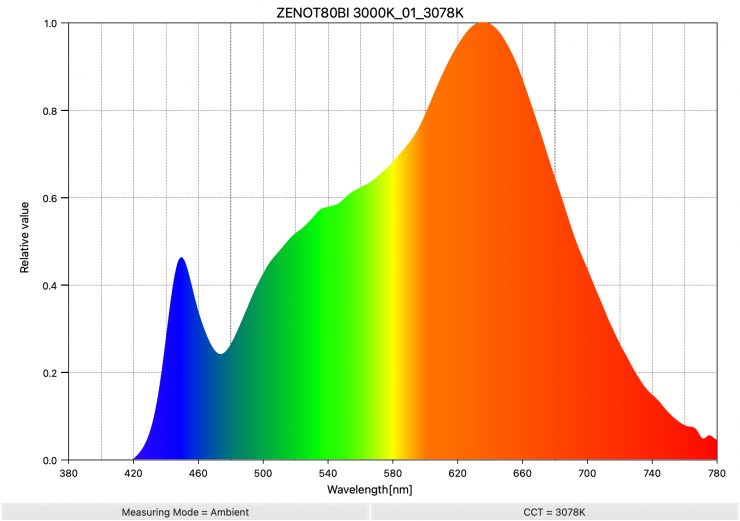
Above you can see the spectral distribution of the ZENIKO OT80 Bi when it is set at 3000K. The spectral distribution is pretty good for a 3000K source.
ZENIKO OT40 Bi 5600K

Above you can see the spectral distribution of the ZENIKO OT80 Bi when it is set at 5600K. The spectral distribution is decent enough.
ZENIKO OT80 Bi 5600K
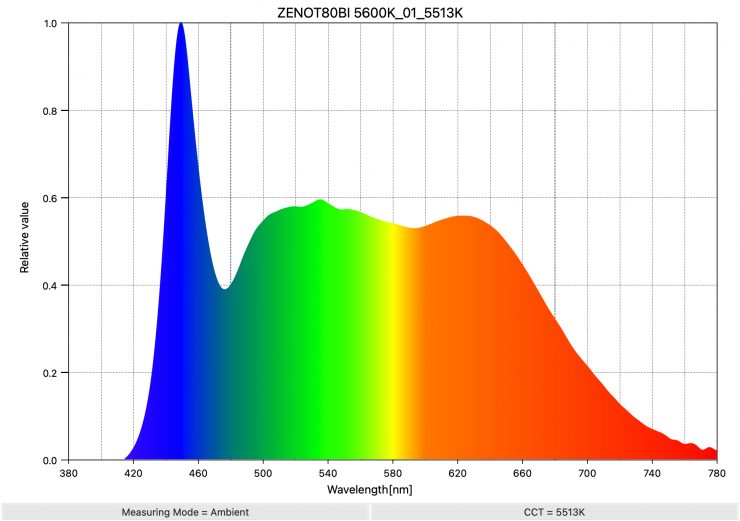
Above you can see the spectral distribution of the ZENIKO OT80 Bi when it is set at 5600K. Again, just like the OT40 Bi, the spectral distribution is decent enough.

As a comparison, let’s compare that against the best LED light I have ever tested at 5600K, the Maxima 3.
Real-World Performance and Quality of Light
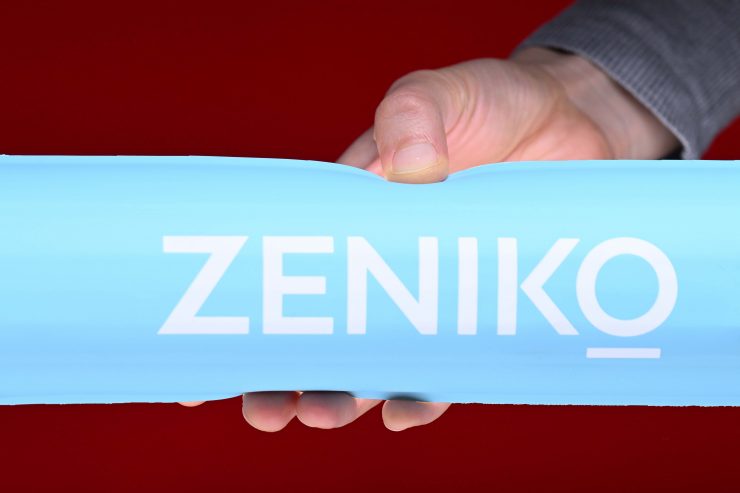
As I always say, photometric scores only tell you part of the story. So do the scores from the ZENIKO fixtures translate into real-world performance? Well, let’s find out.

As far as how the lights look, you can produce a nice soft source, however, this does come at the sacrifice of output. You have to remember that it is a small sized source with a small power draw.
They aren’t overly bright and that does somewhat limit what you can use the lights for. In saying that, you do have to remember that you are getting that output over a fairly large area. I also think for its intended use, it is bright enough.
These certainly aren’t fixtures that I would use for lighting up spaces. You could use the ZENIKO OT80 Bi as a key light in a pinch, but that would really depend on the environment you were working in.
Having a compact and inflatable LED source certainly has its advantages when you just ned to add a little bit of fill or ambient light to a scene. You could also use them as accent lights as long as they aren’t being clearly seen.
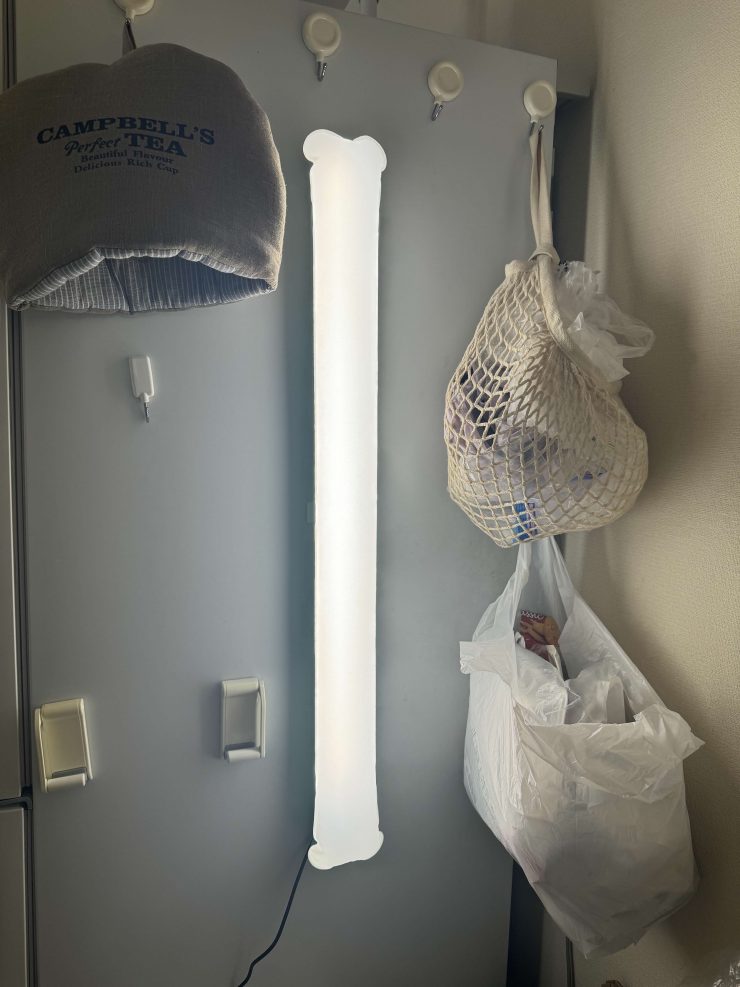
It is nice that you can mount them to objects using the magnets, however, your other mounting options are a little limiting because of the design. The back straps don’t see to be overly strong and I would be worried about breaking them if you put anything something through them.
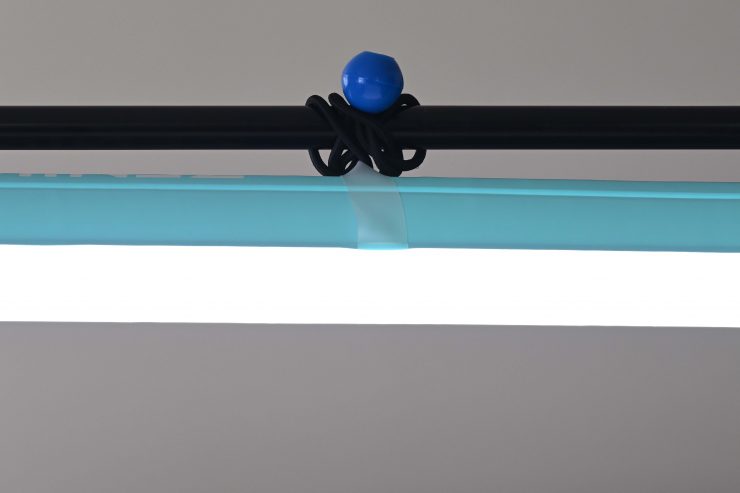
I would personally just use some bungee style cords or string etc. if you want to mount them to something using these tabs.
Price
The ZENKO OT40 Bi retails for $29 USD, and the OT80 Bi retails for $39 USD.
Conclusion
The ZENKO OT40 Bi and OT80 Bi are in-expensive lights and while there’s a lot to like, they aren’t going to be fixtures for everyone as they can be difficult to mount and they don’t have a lot of output.
For just keeping in your kit, they make a lot of sense, as they don’t take up much space and they barely weigh anything. Having the ability to pull out a small fixture that can produce a reasonably broad and soft source is certainly handy for some situations.
I do wish that they went with USB-C instead of USB-A, but that’s a minor complaint. The biggest caveat is arguably the limited CCT adjustment.
The lights are quick to set up and use, and the photometric scores across the board are pretty good, although they are more accurate at 4600K and below.
There is no app and the controls are a bit limiting, but you know what, for the cost that these lights retail for, I didn’t find it to be a deal breaker.
Despite some of the issues I mentioned, the lights provide good value for money. They are lightweight, portable, don’t require much power and they produce decent results. I would buy them just to have a couple of small back-up lights in my kit.
